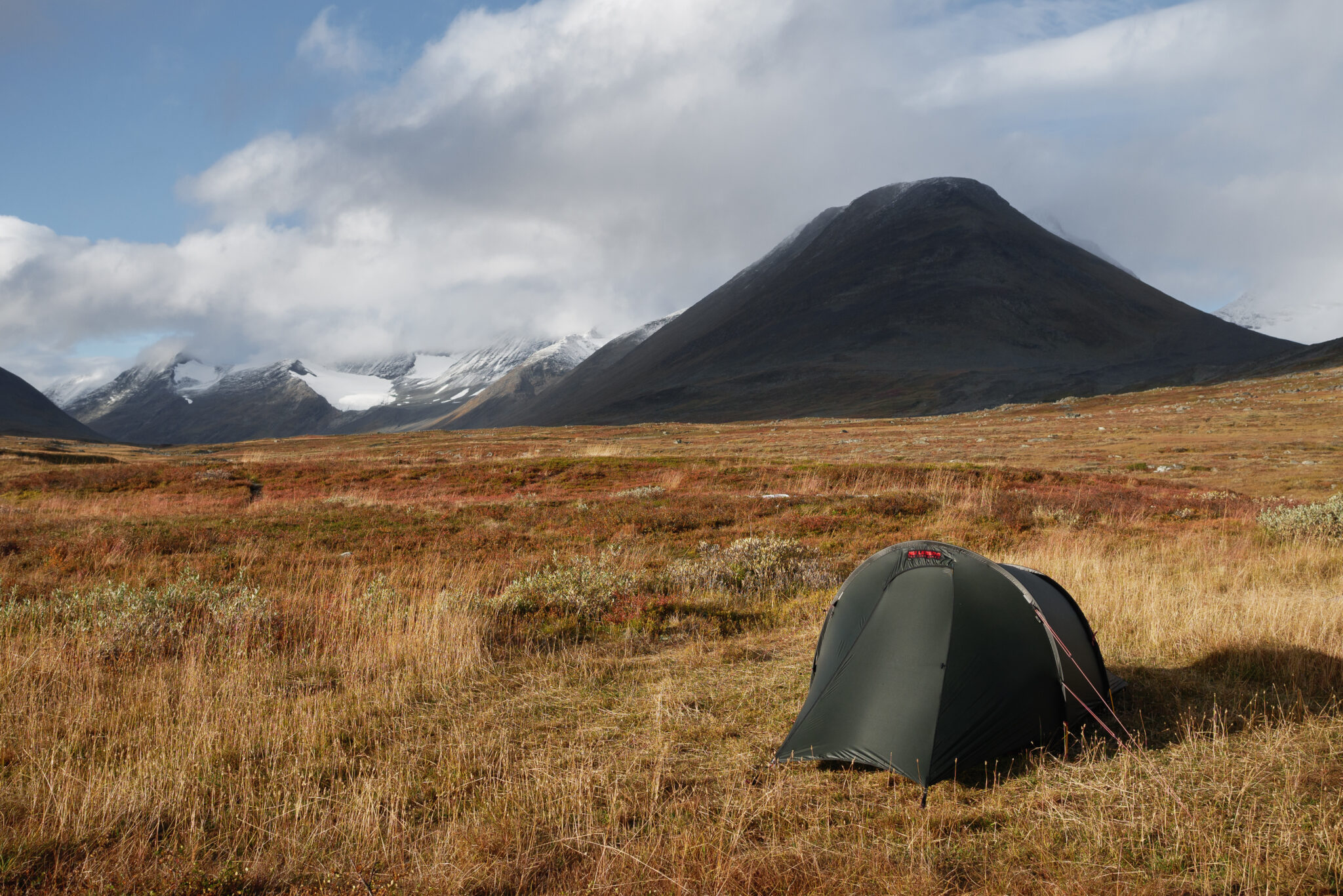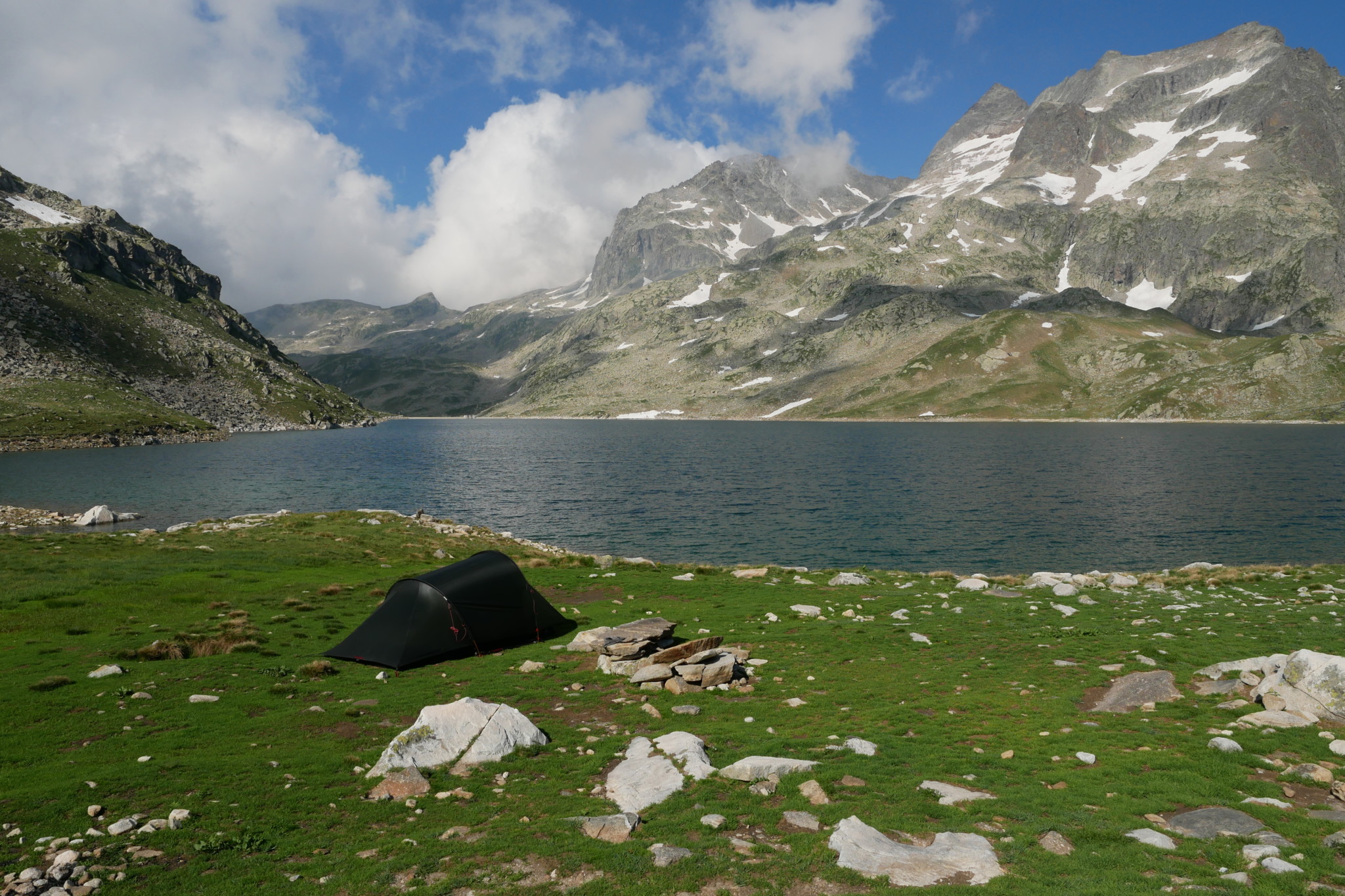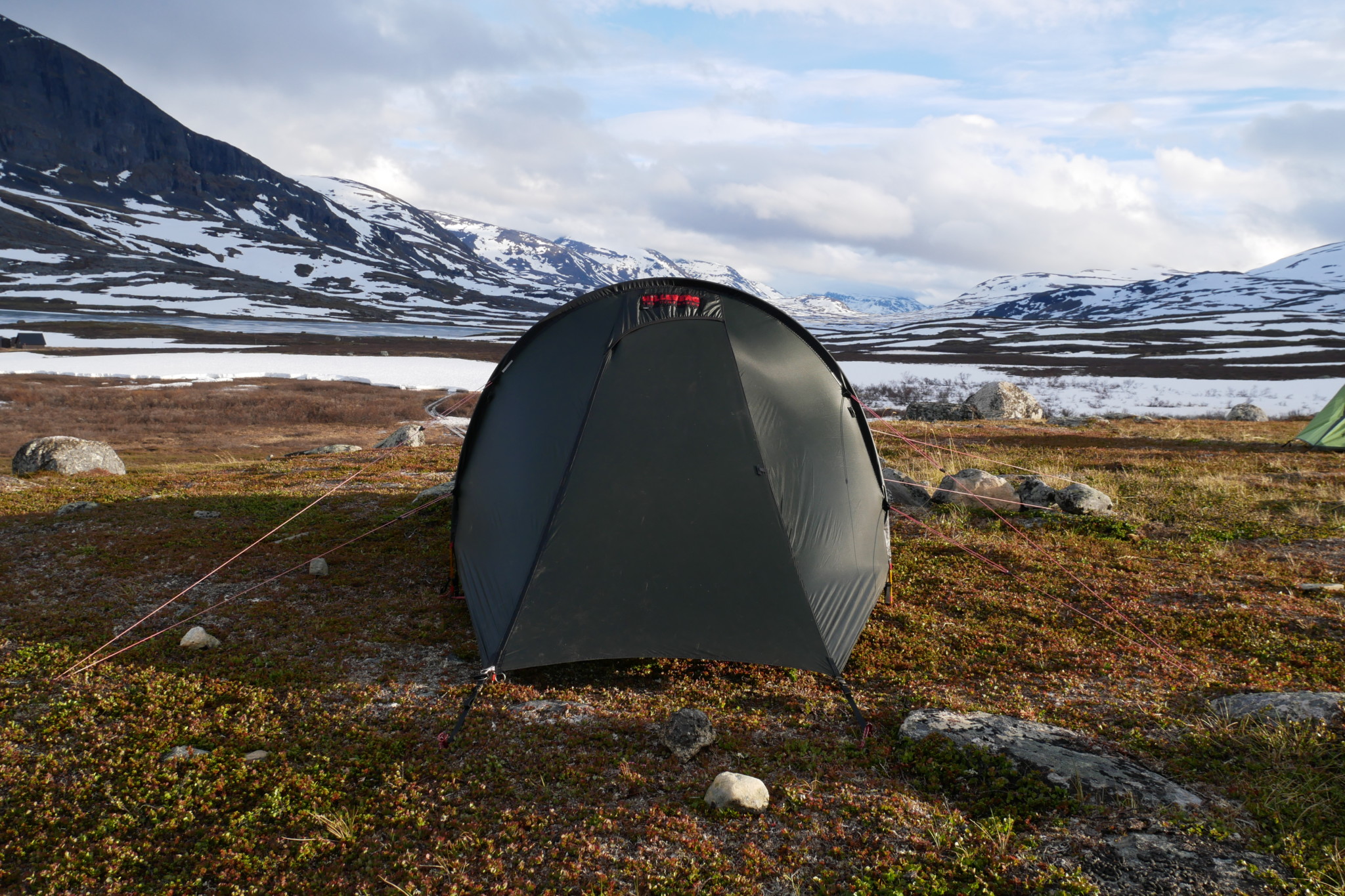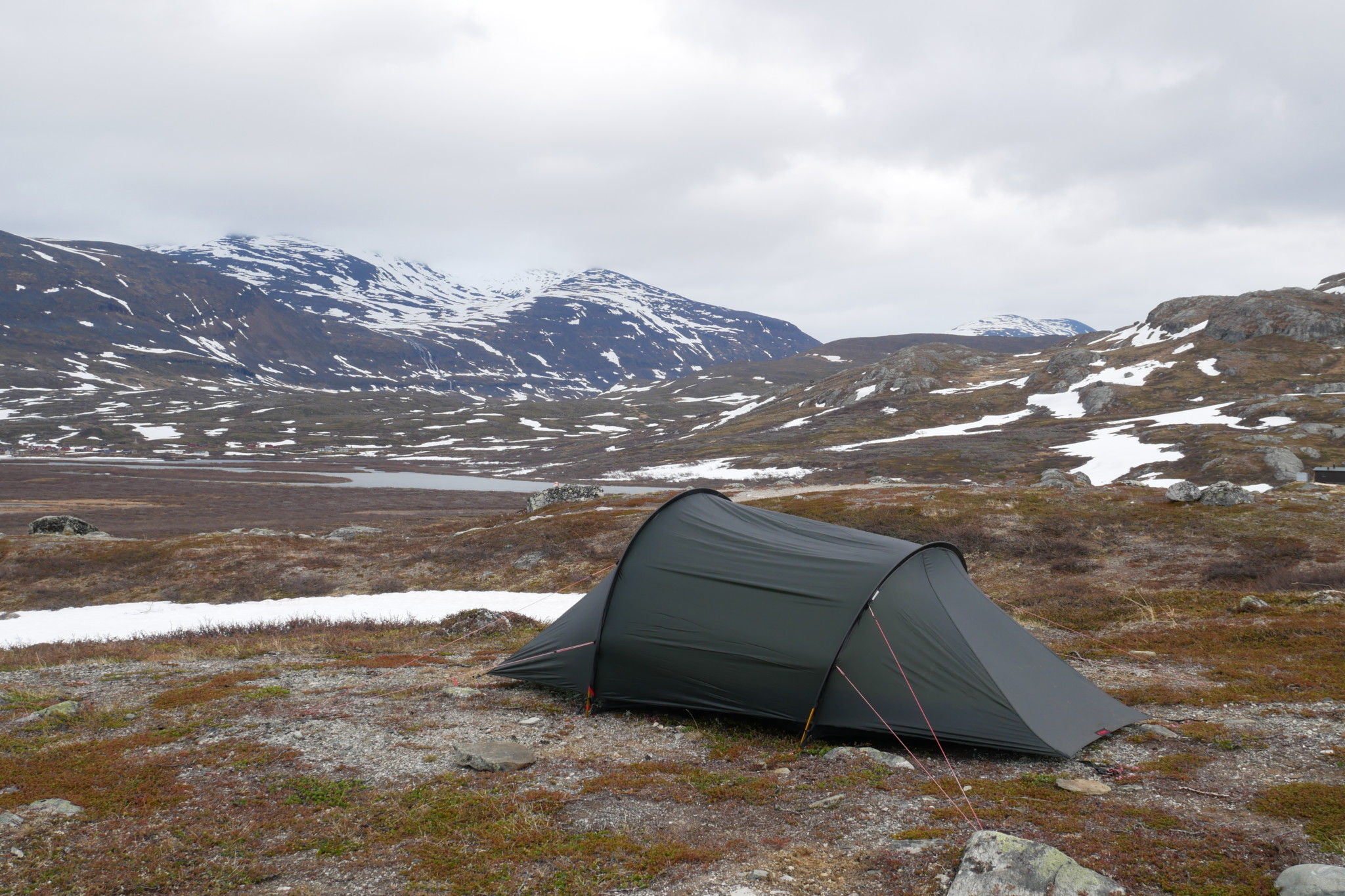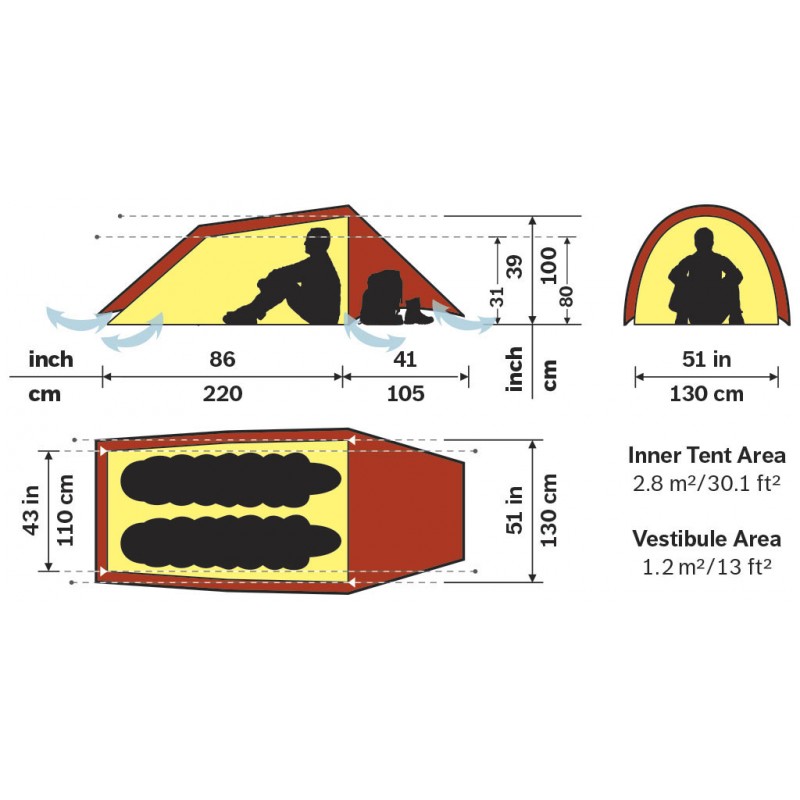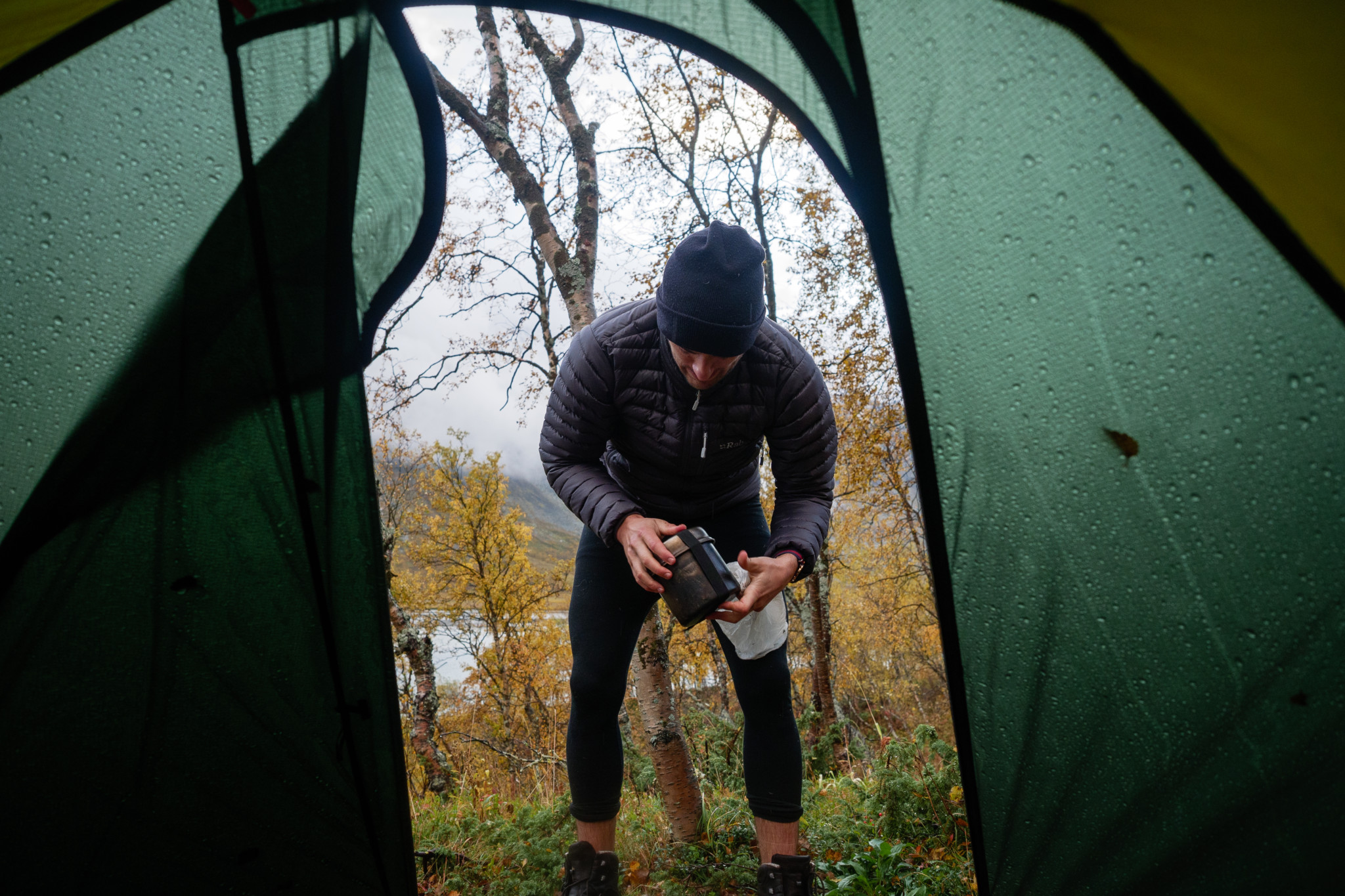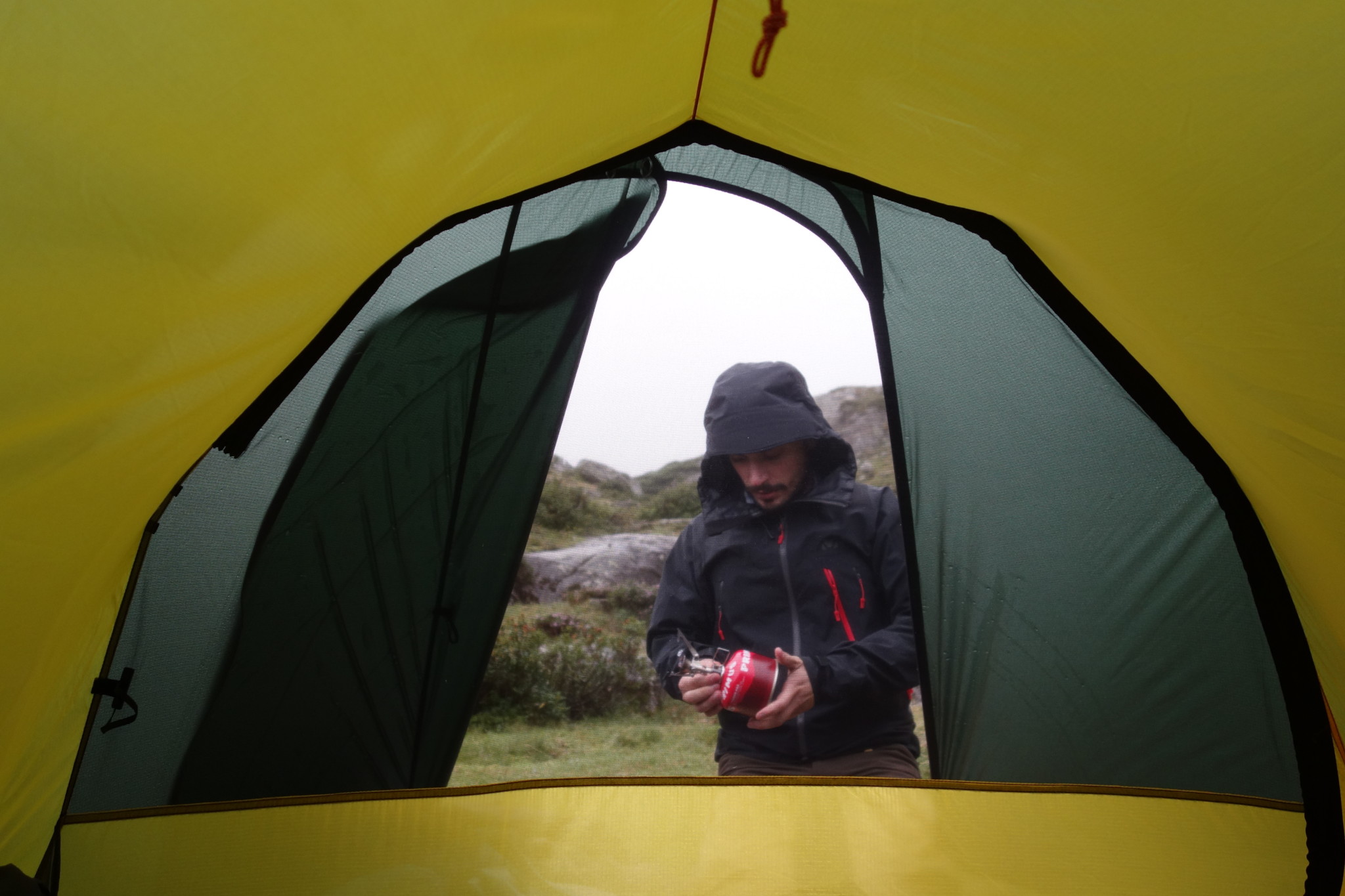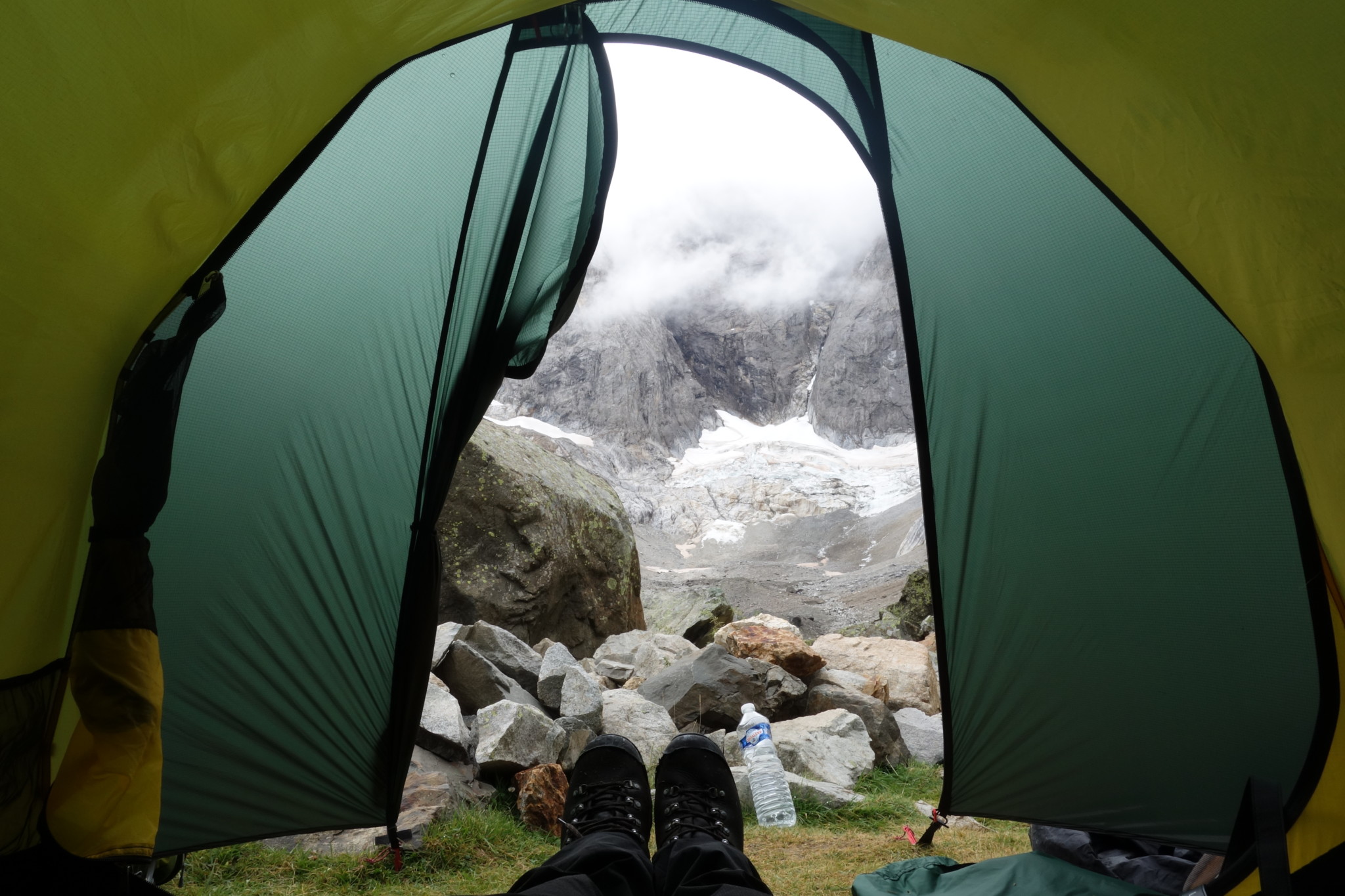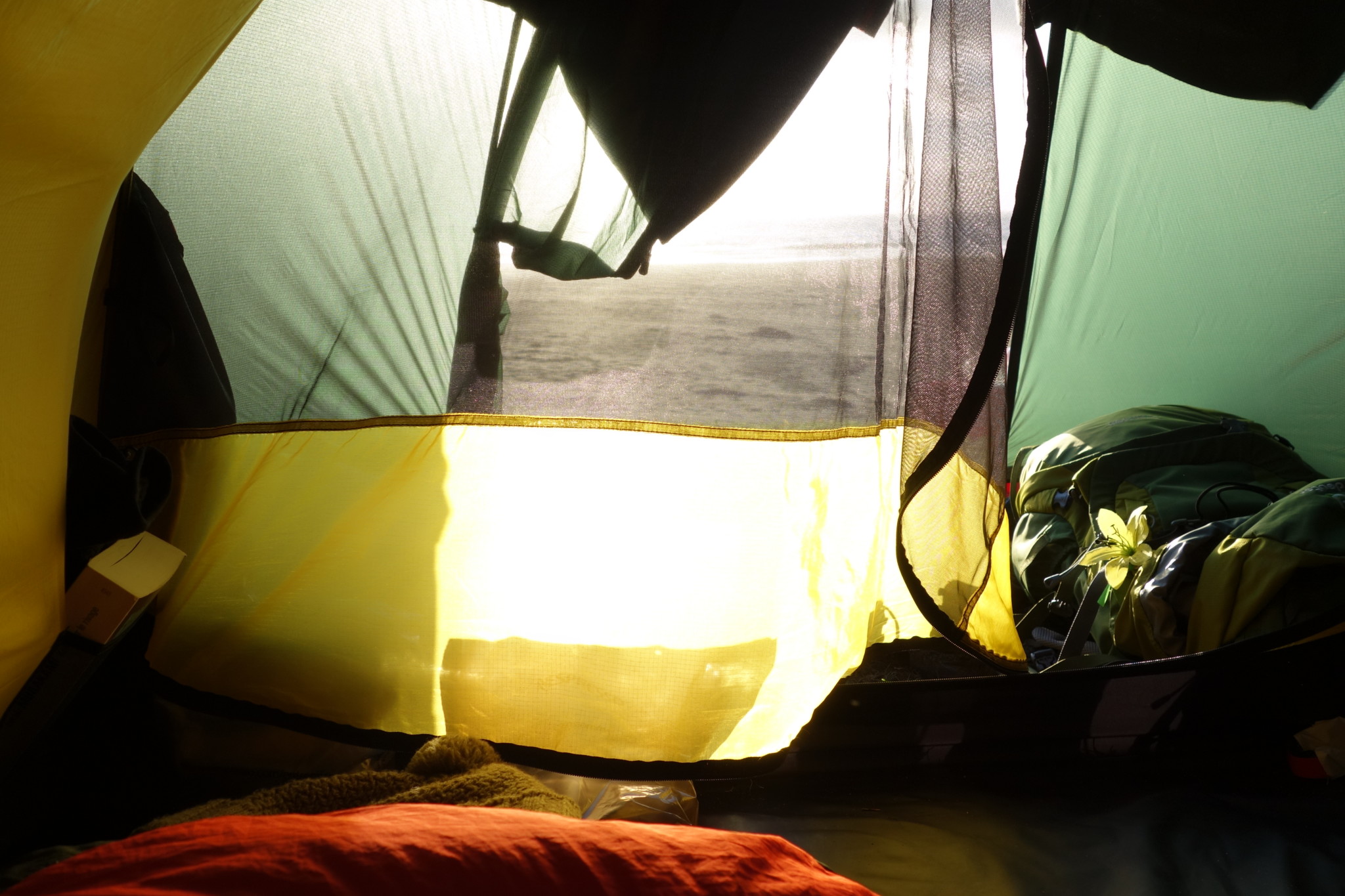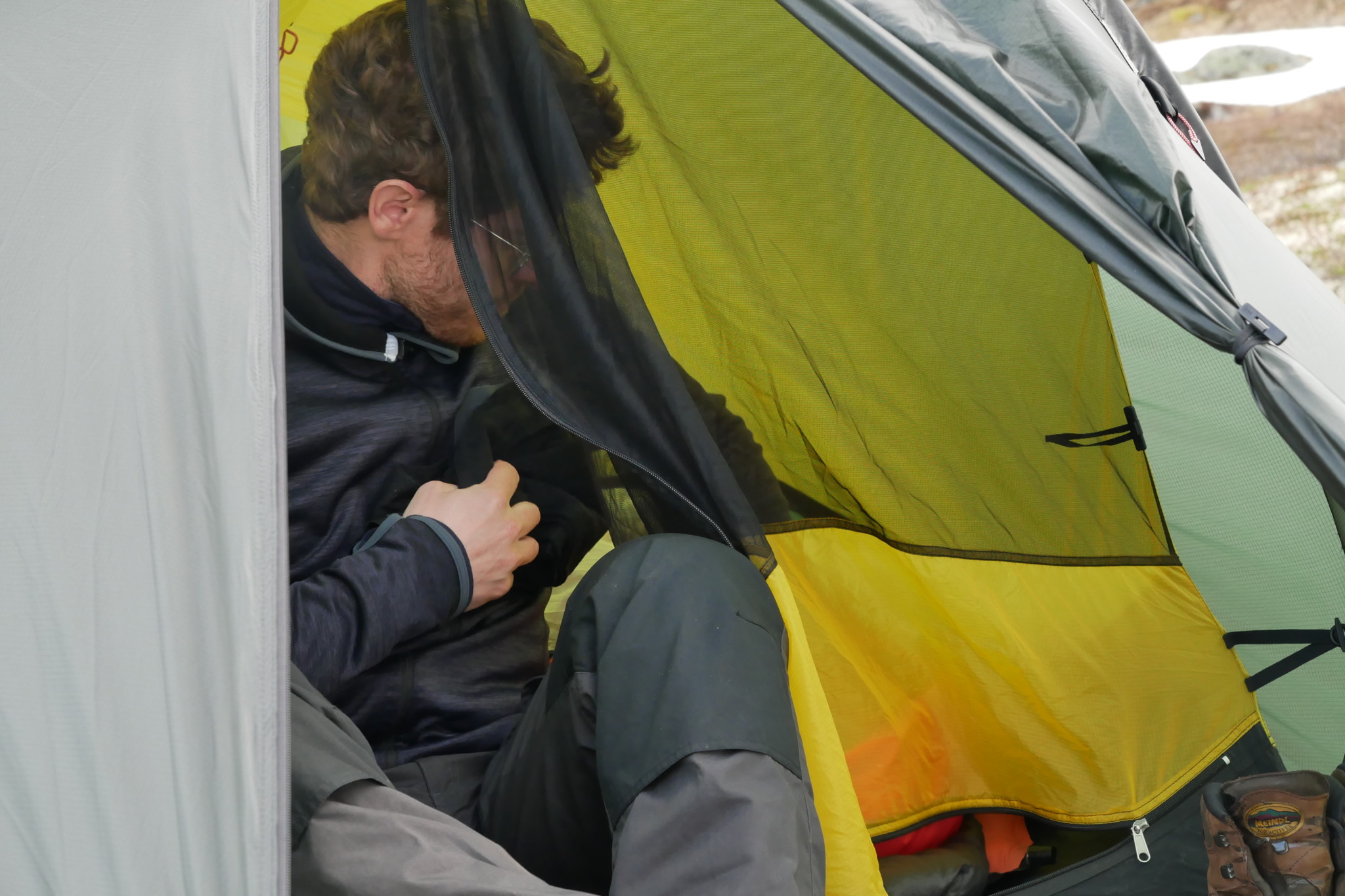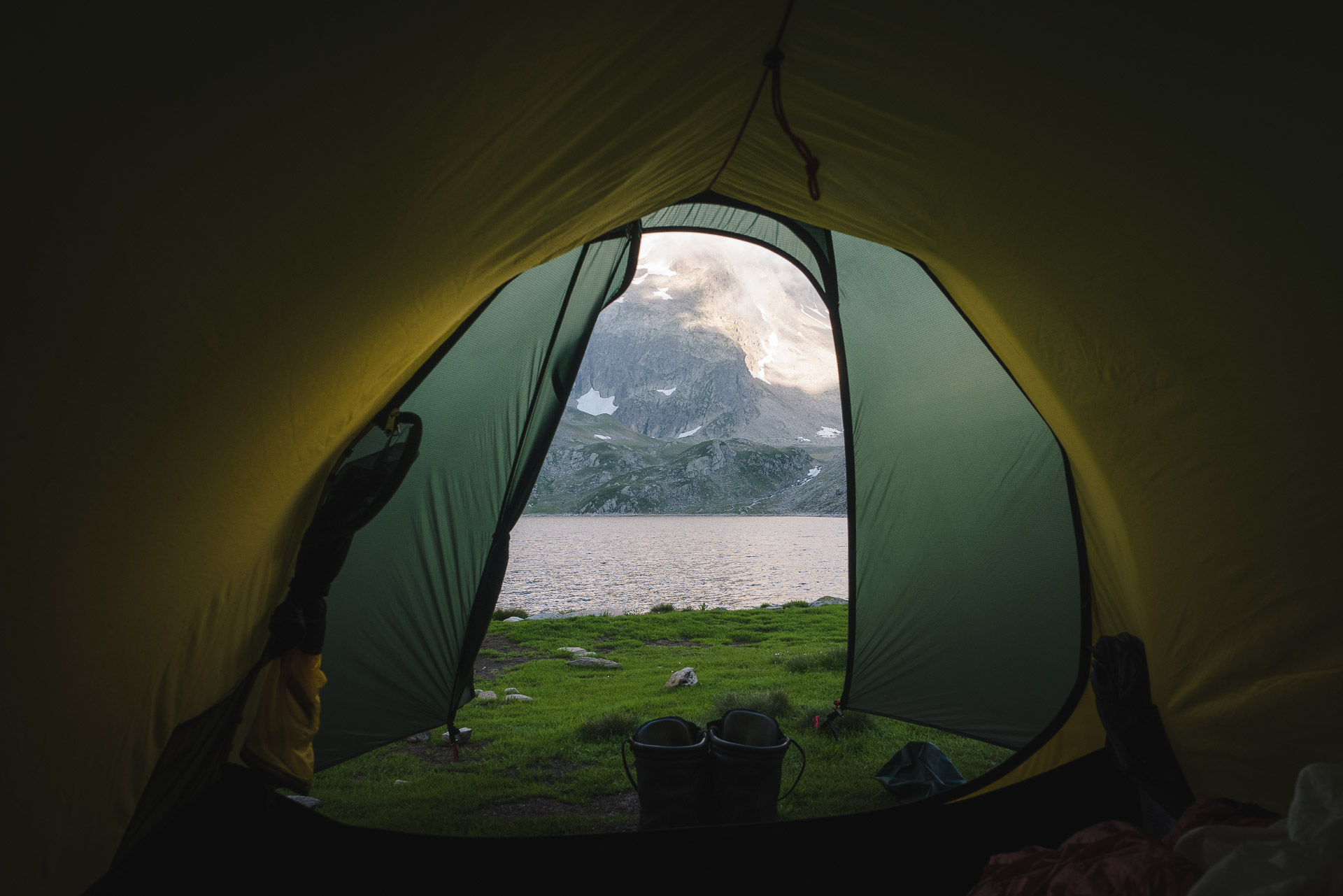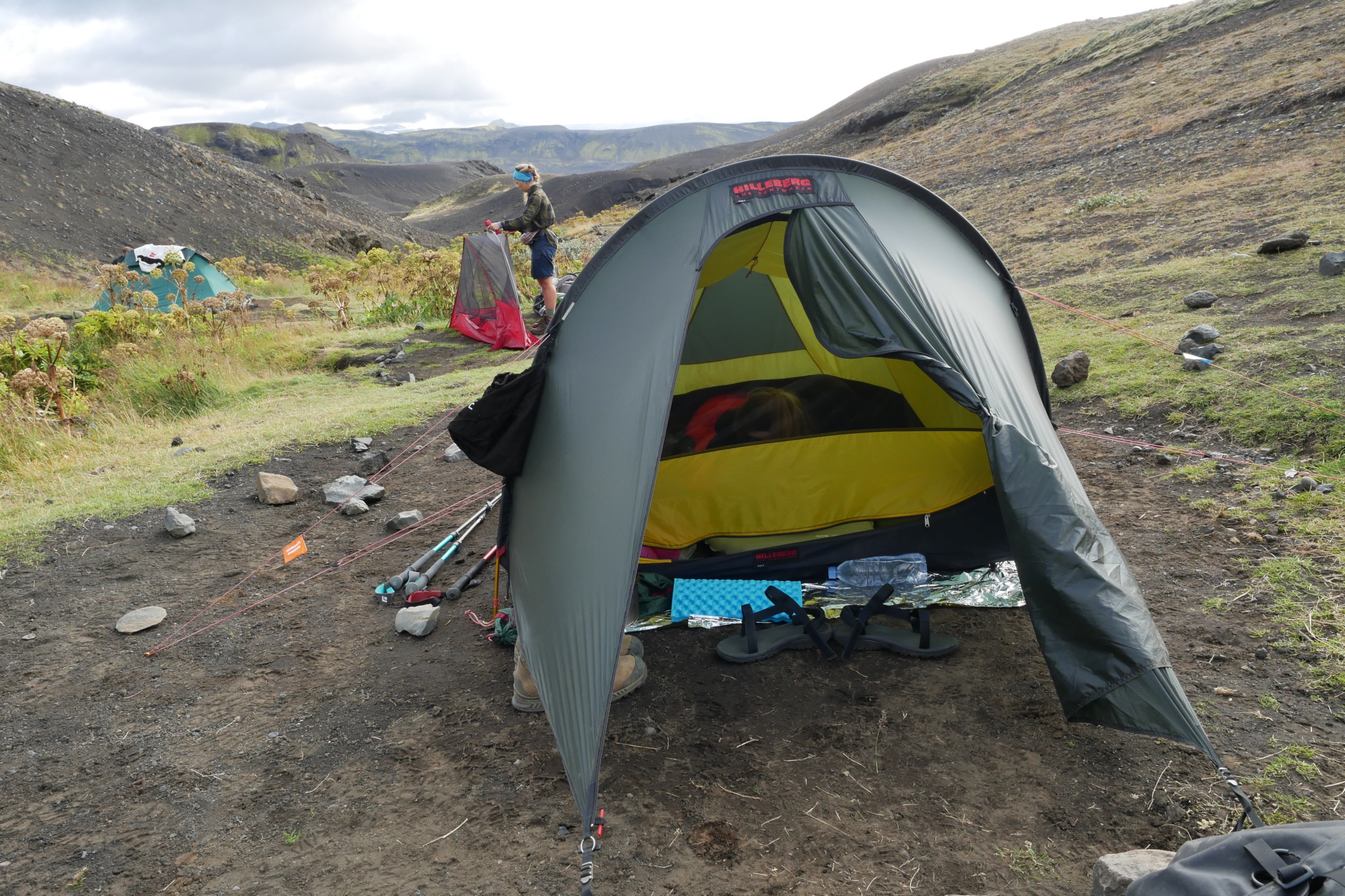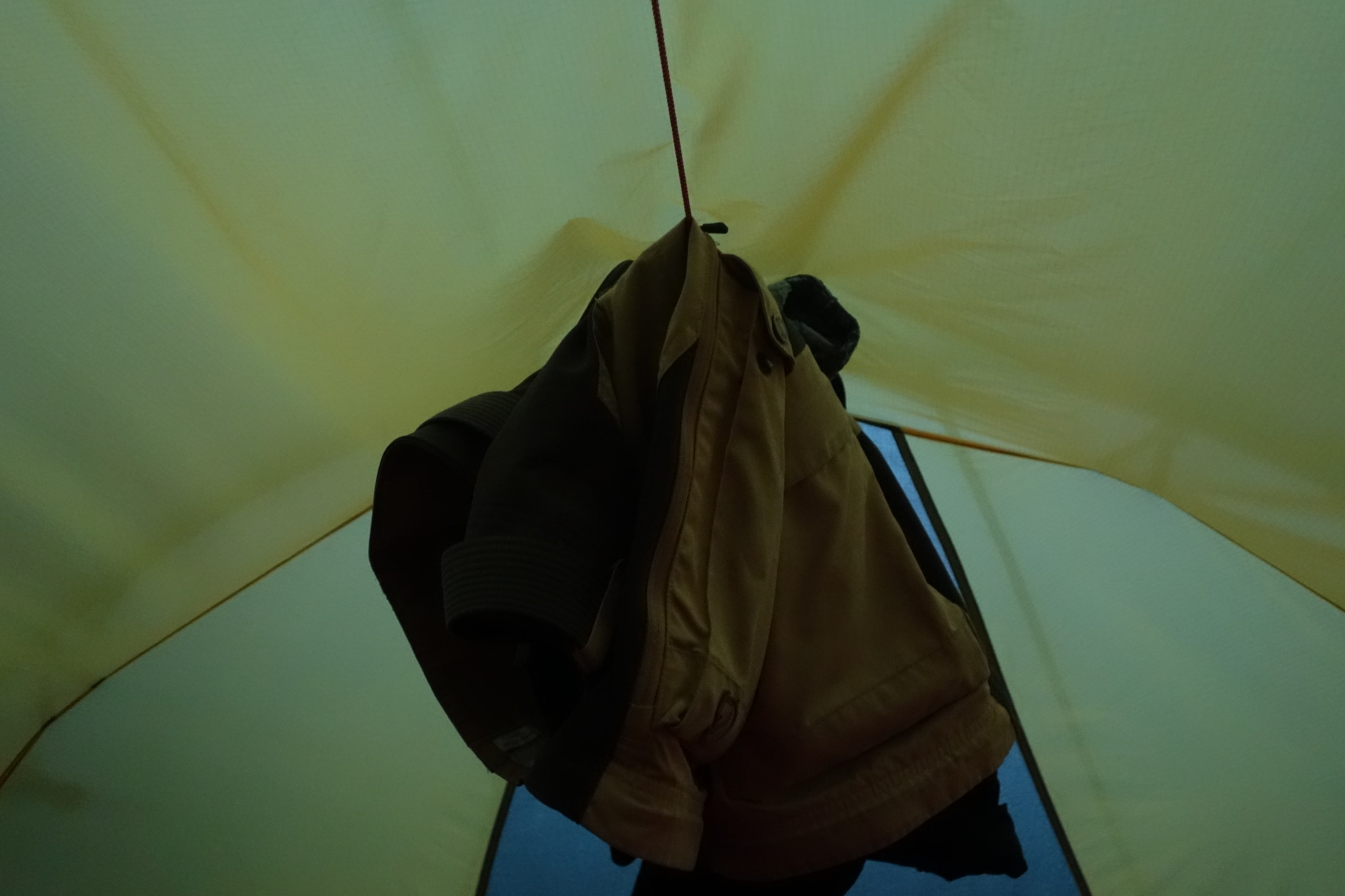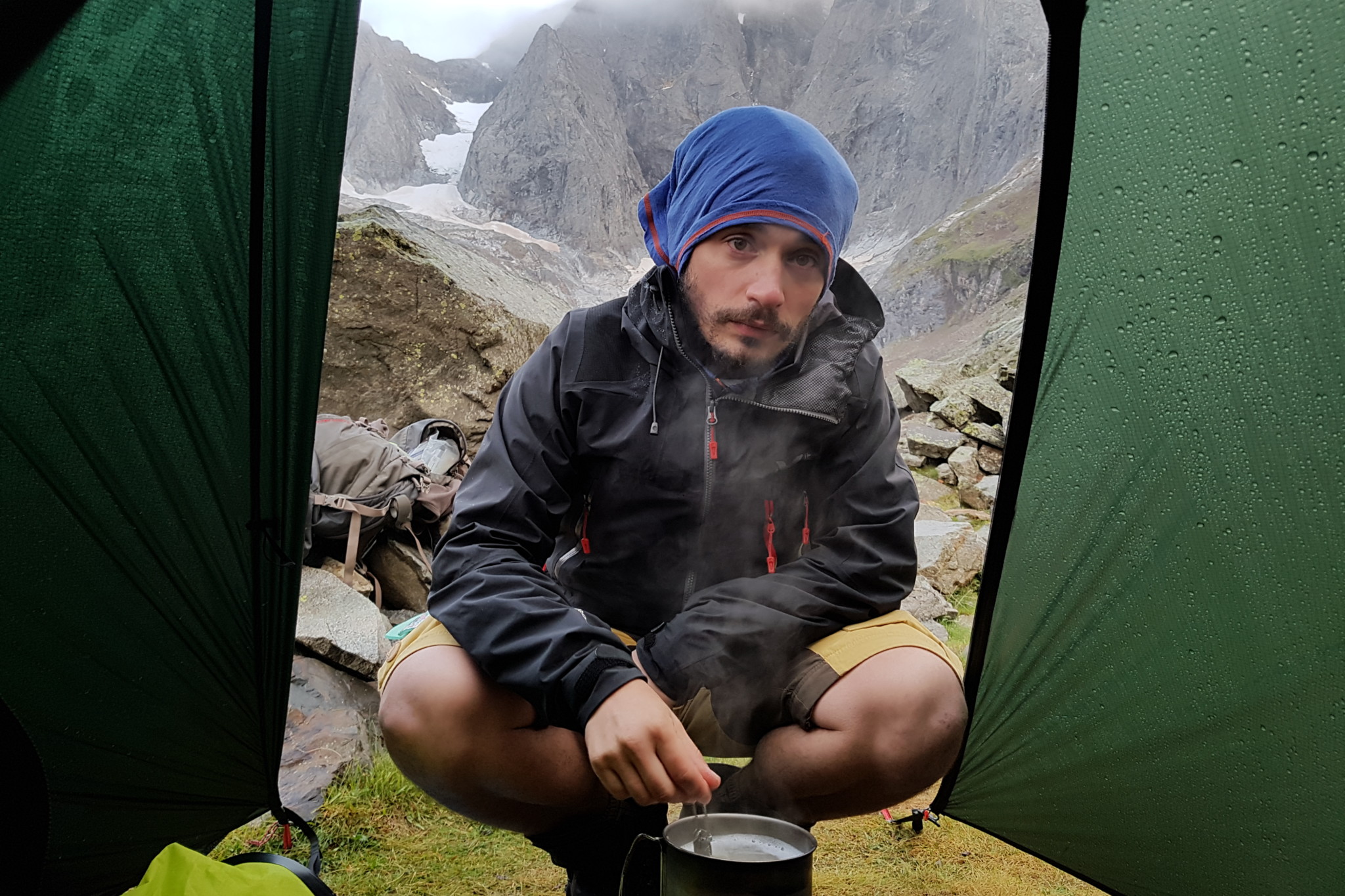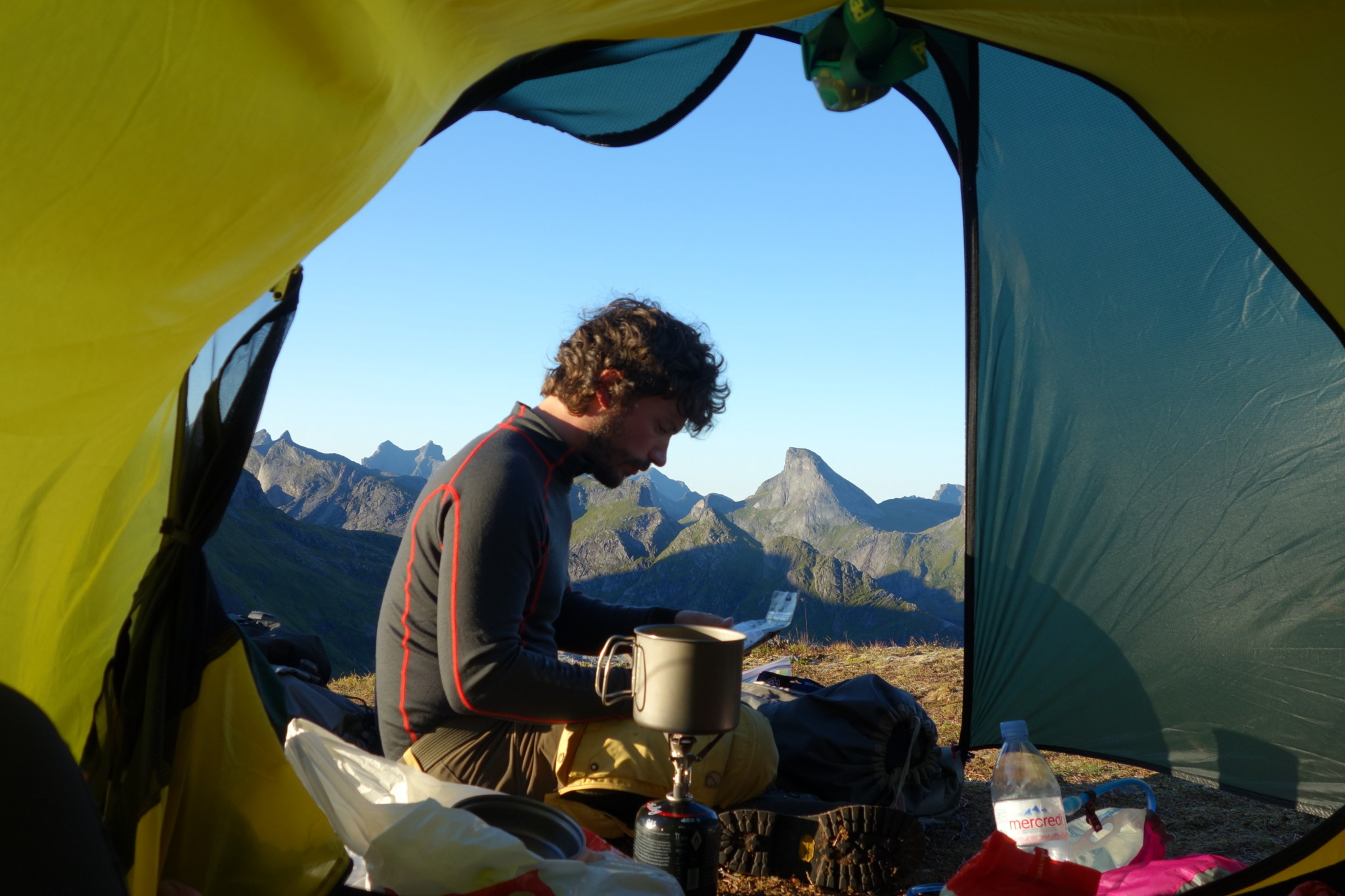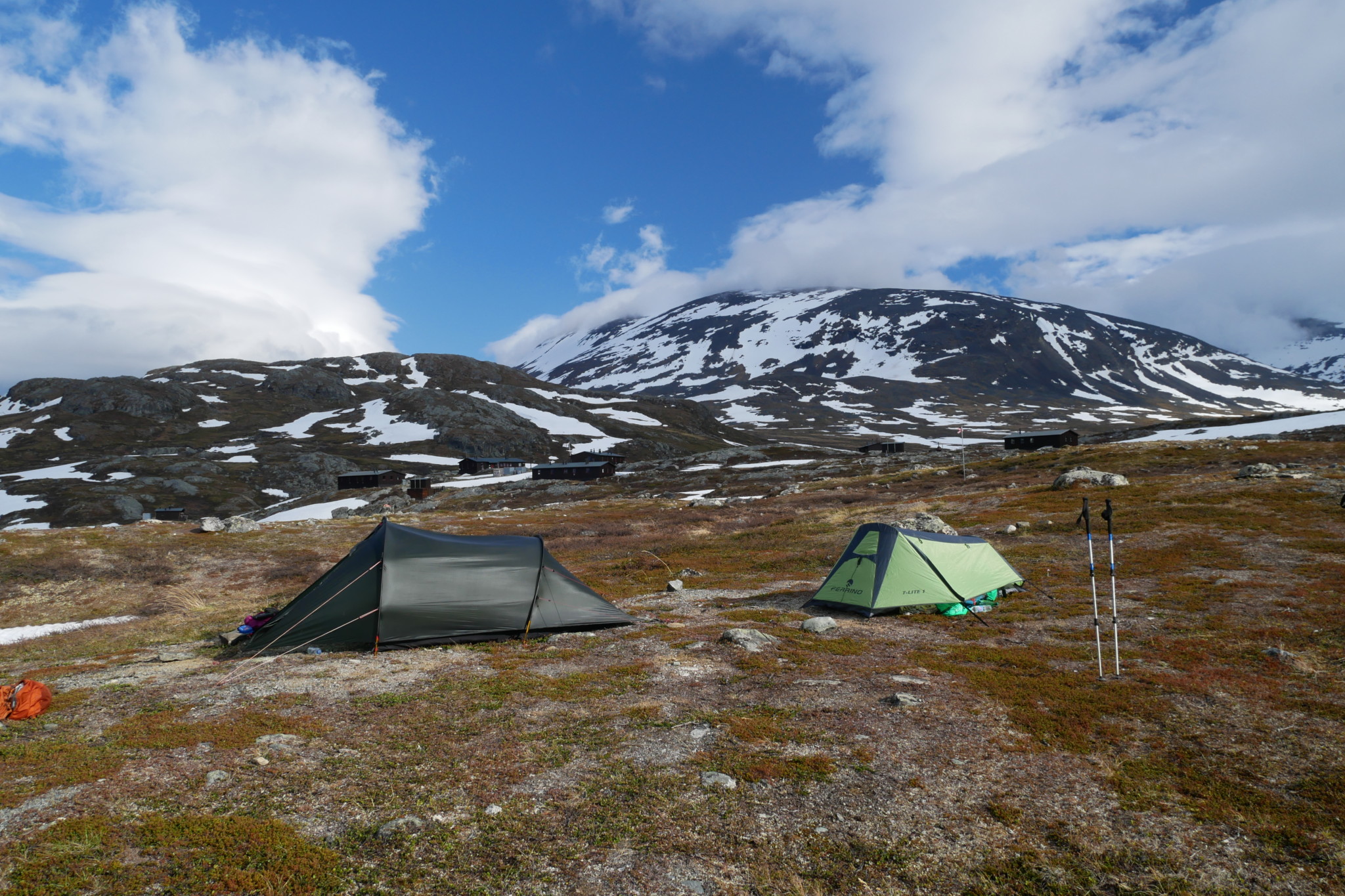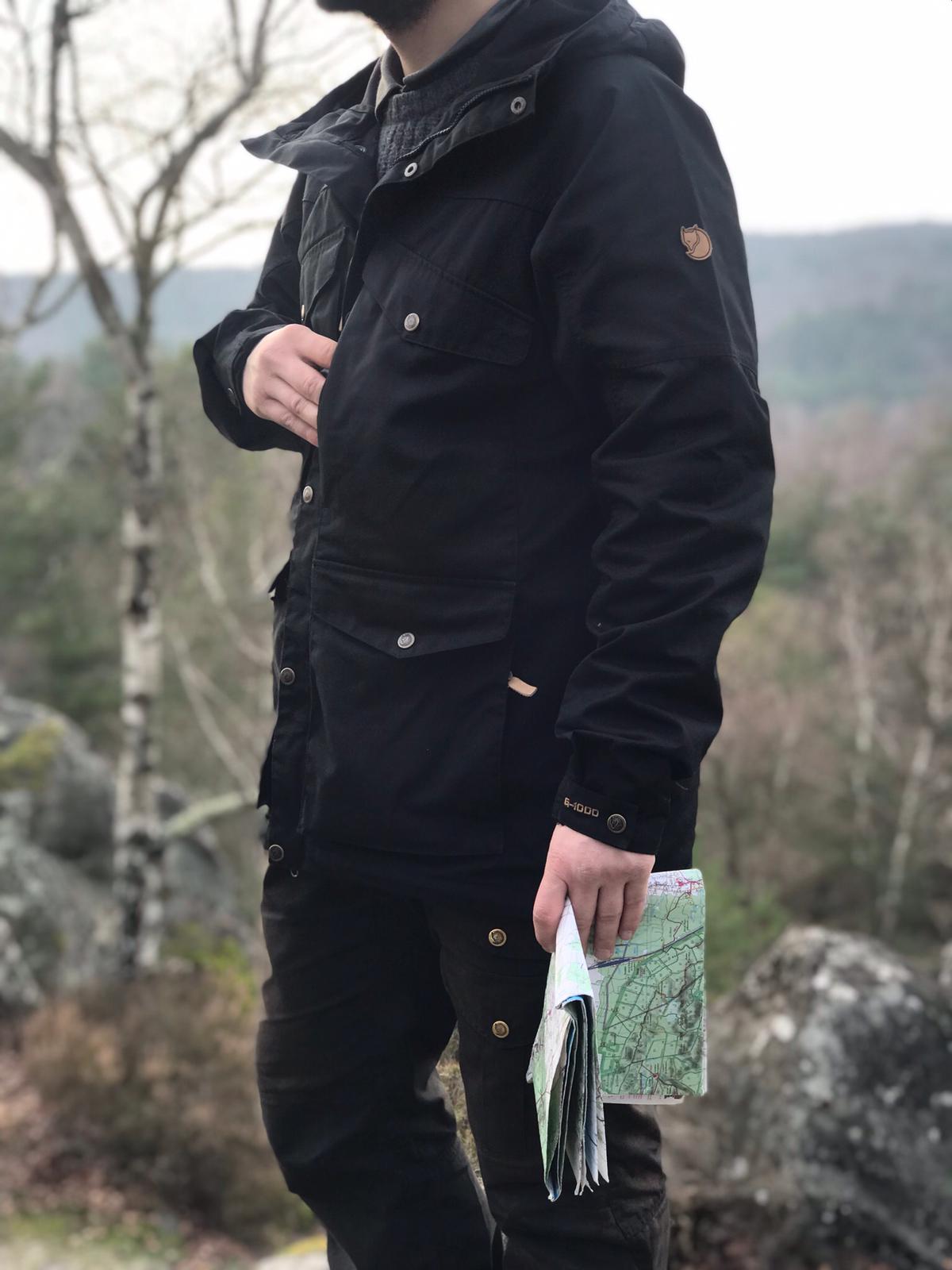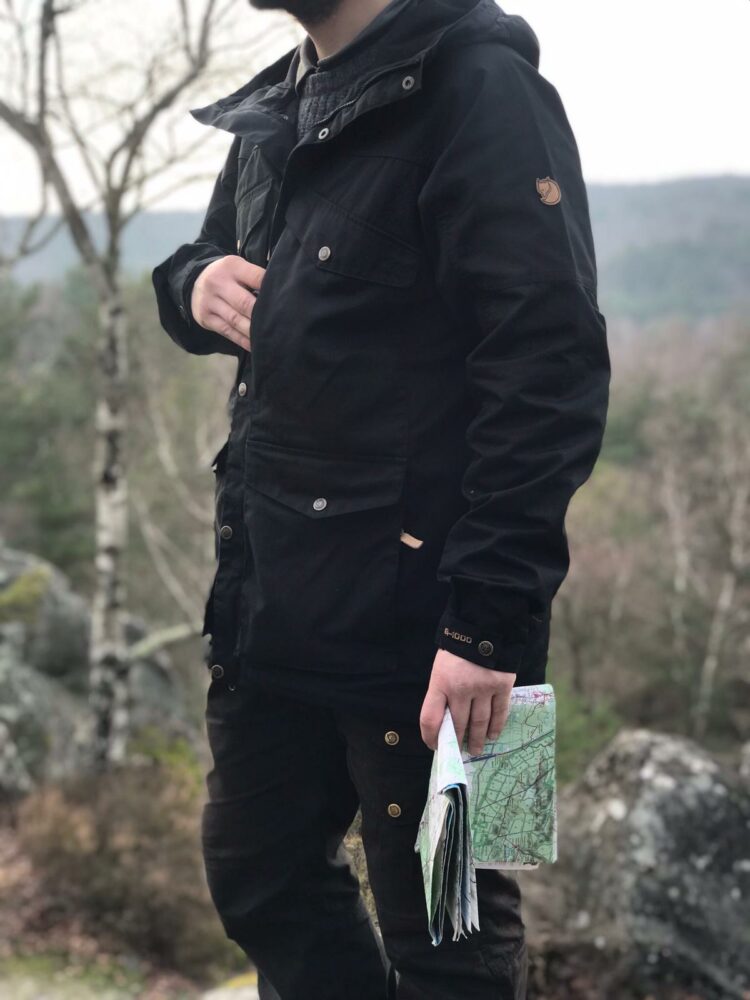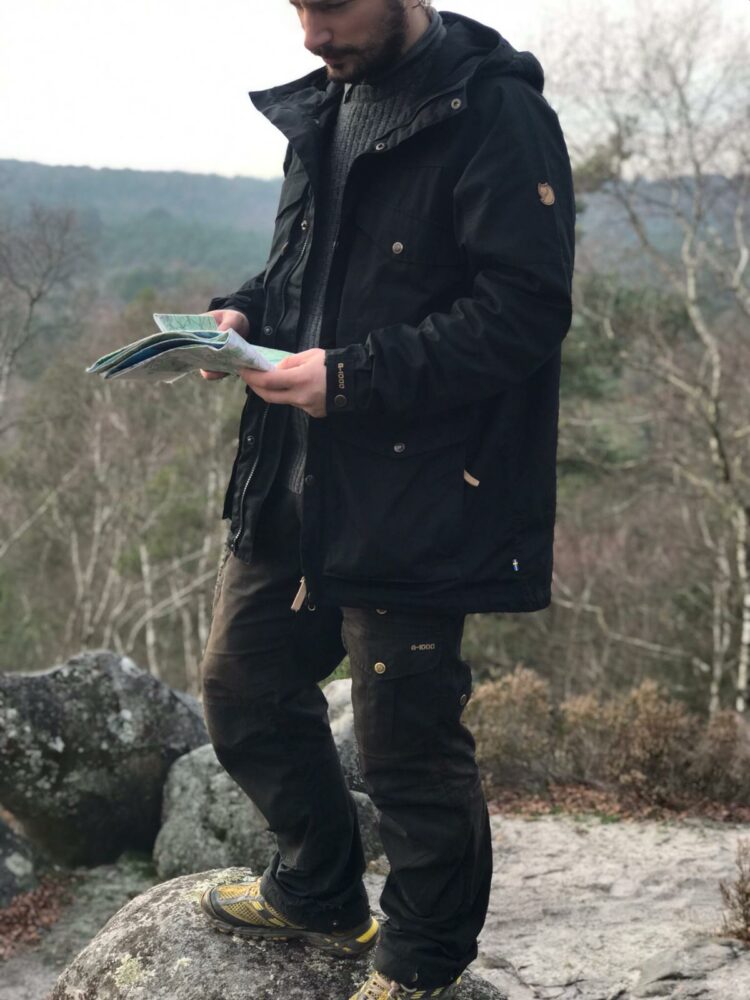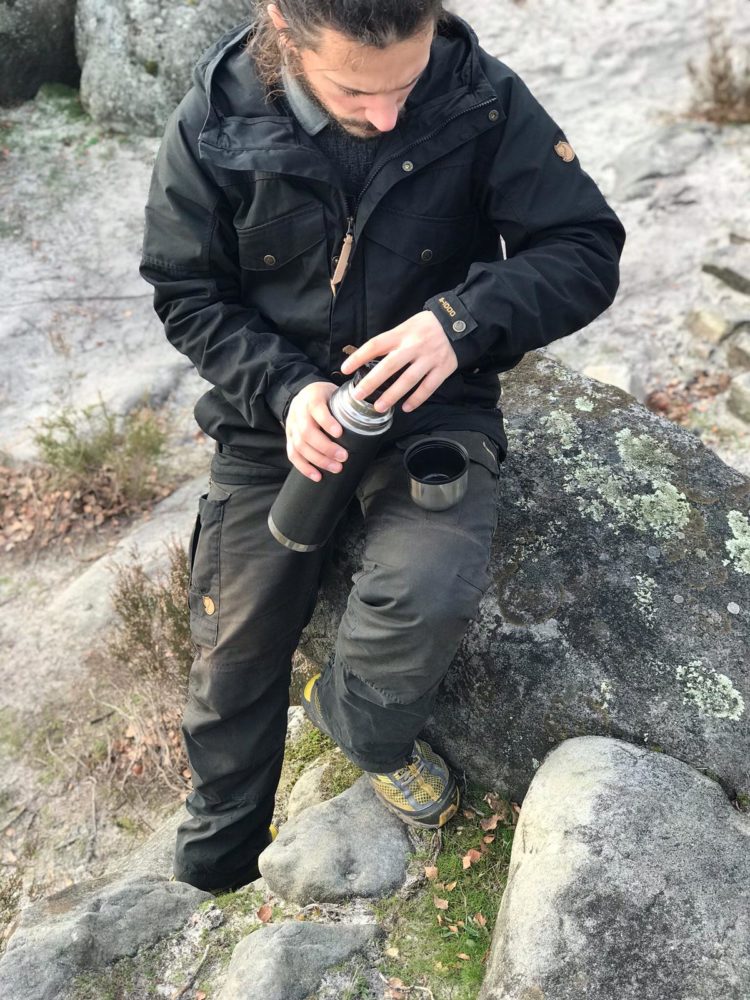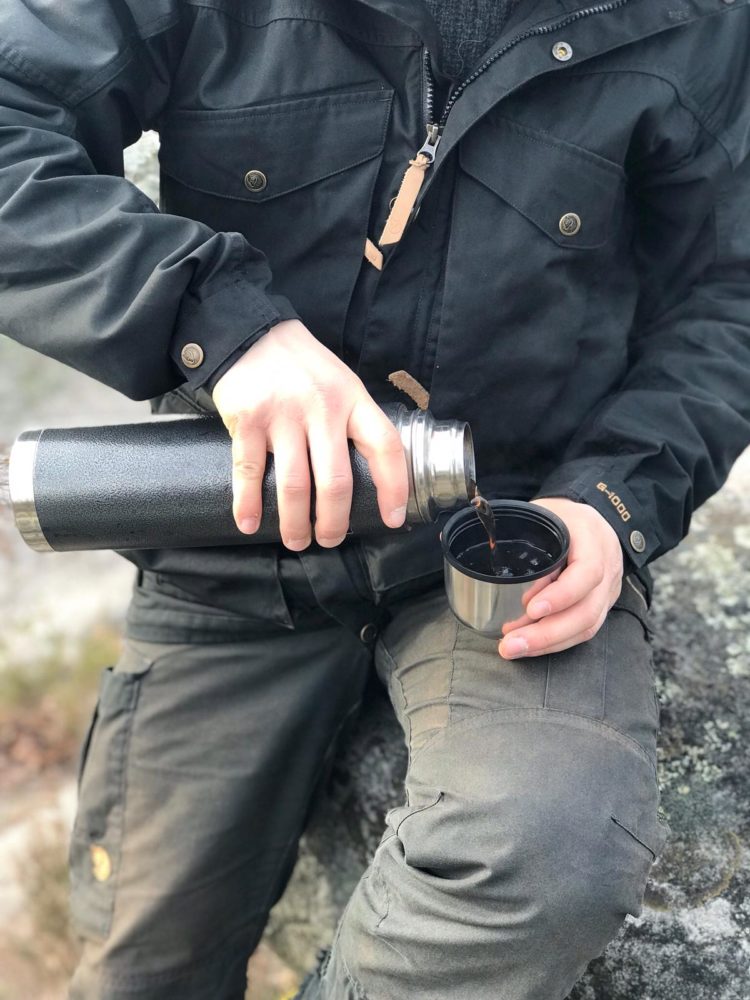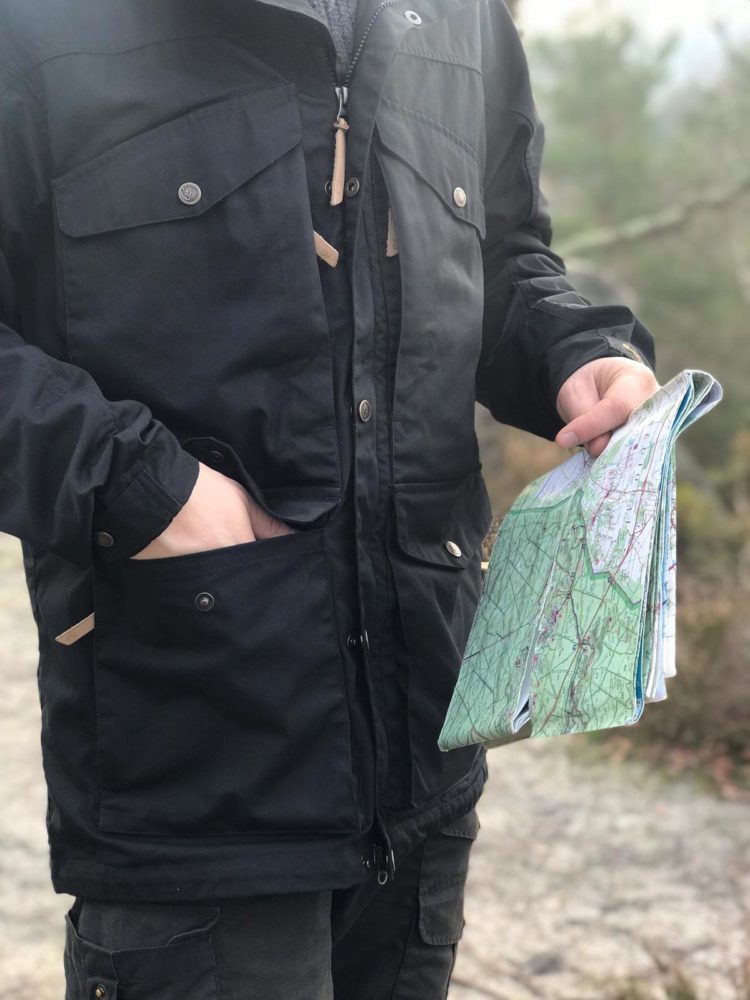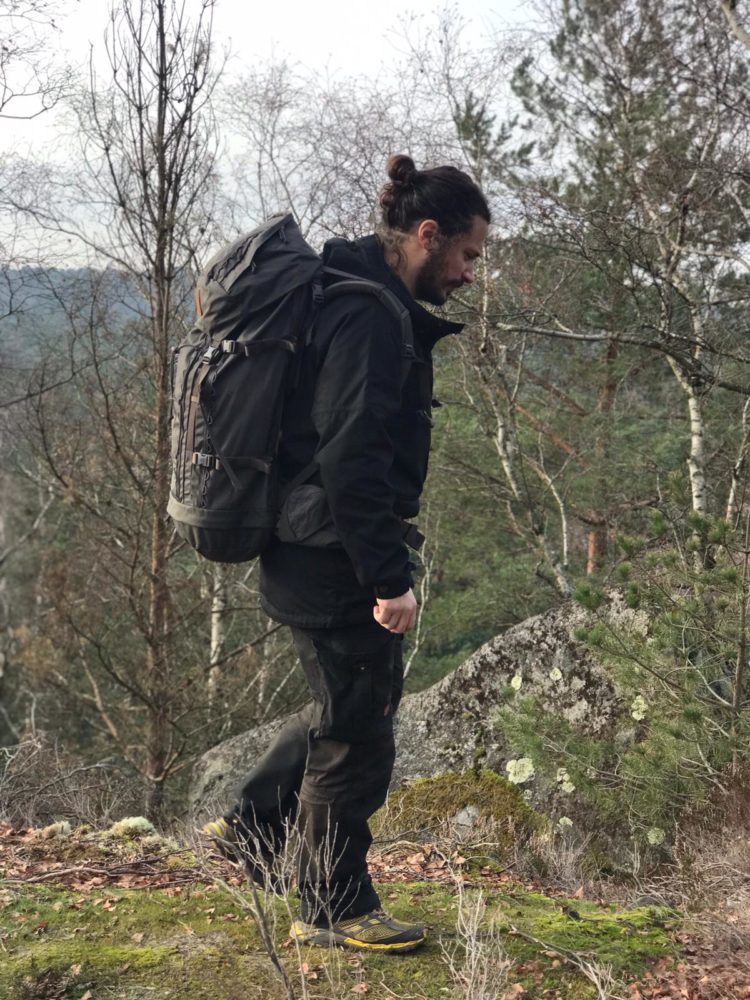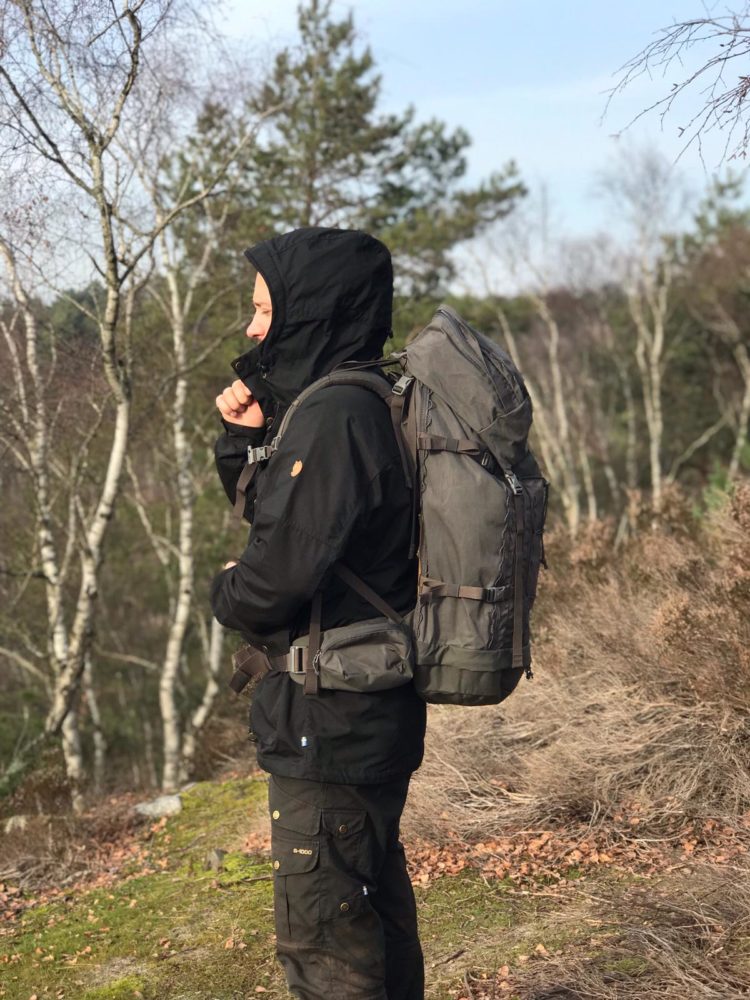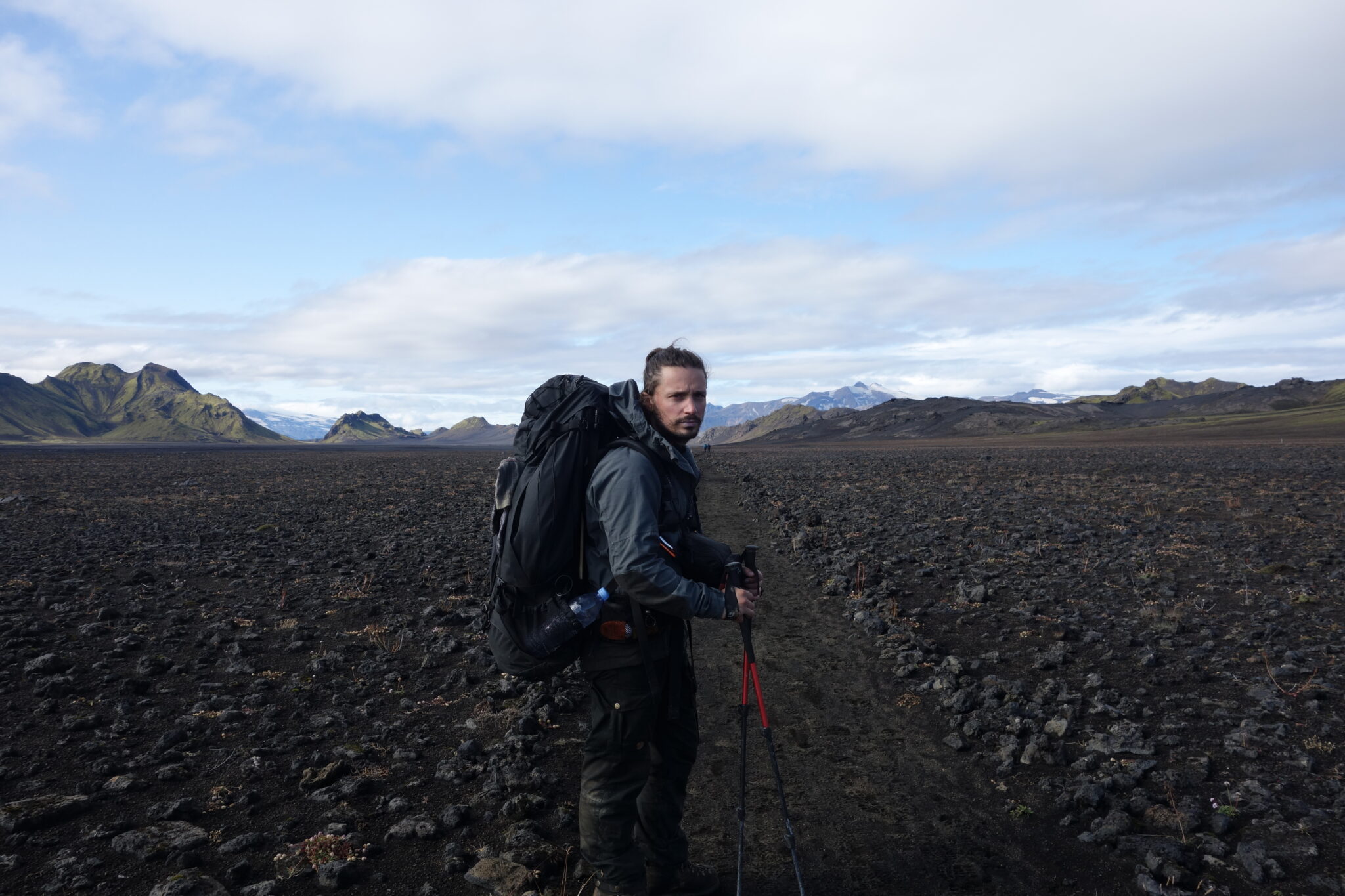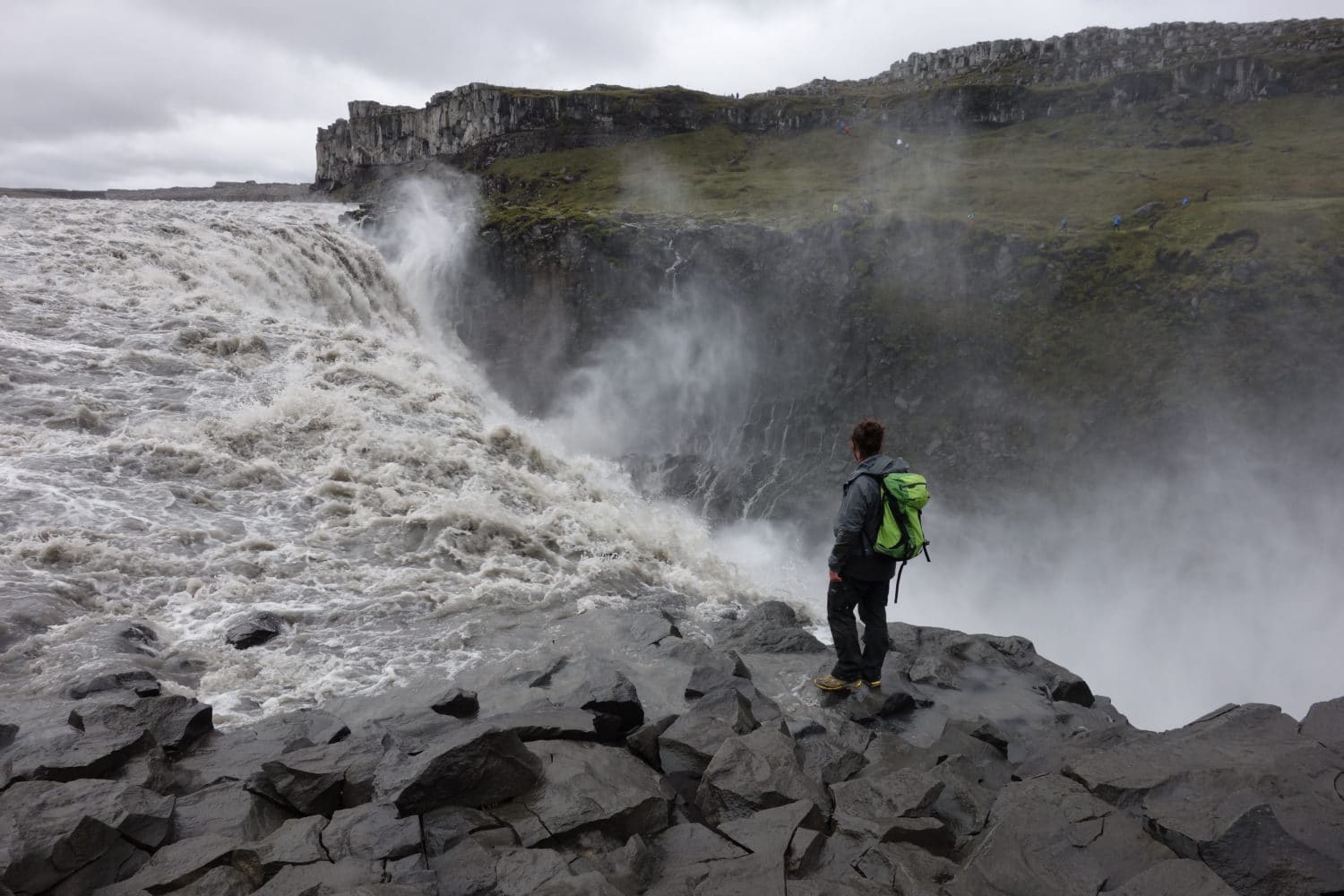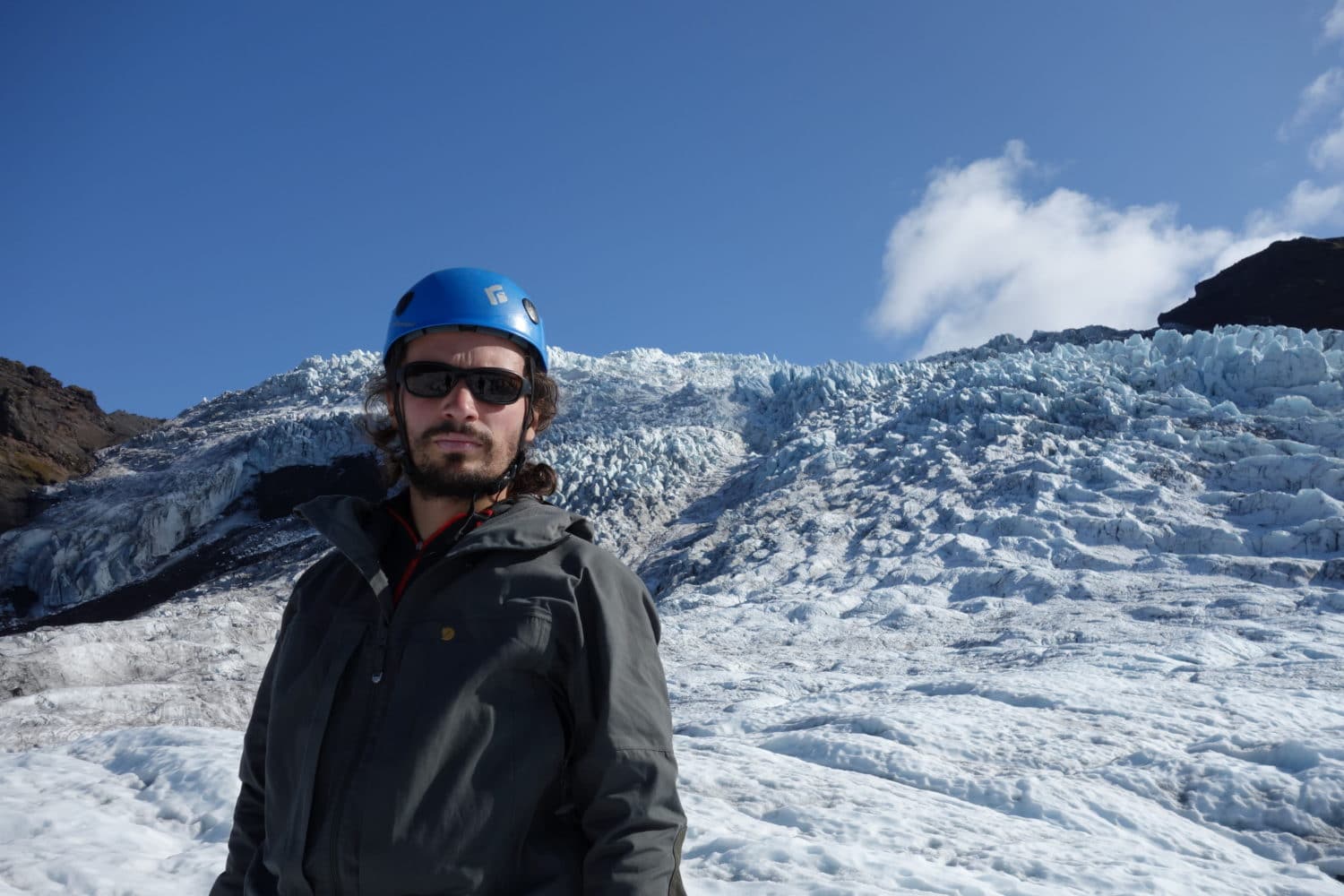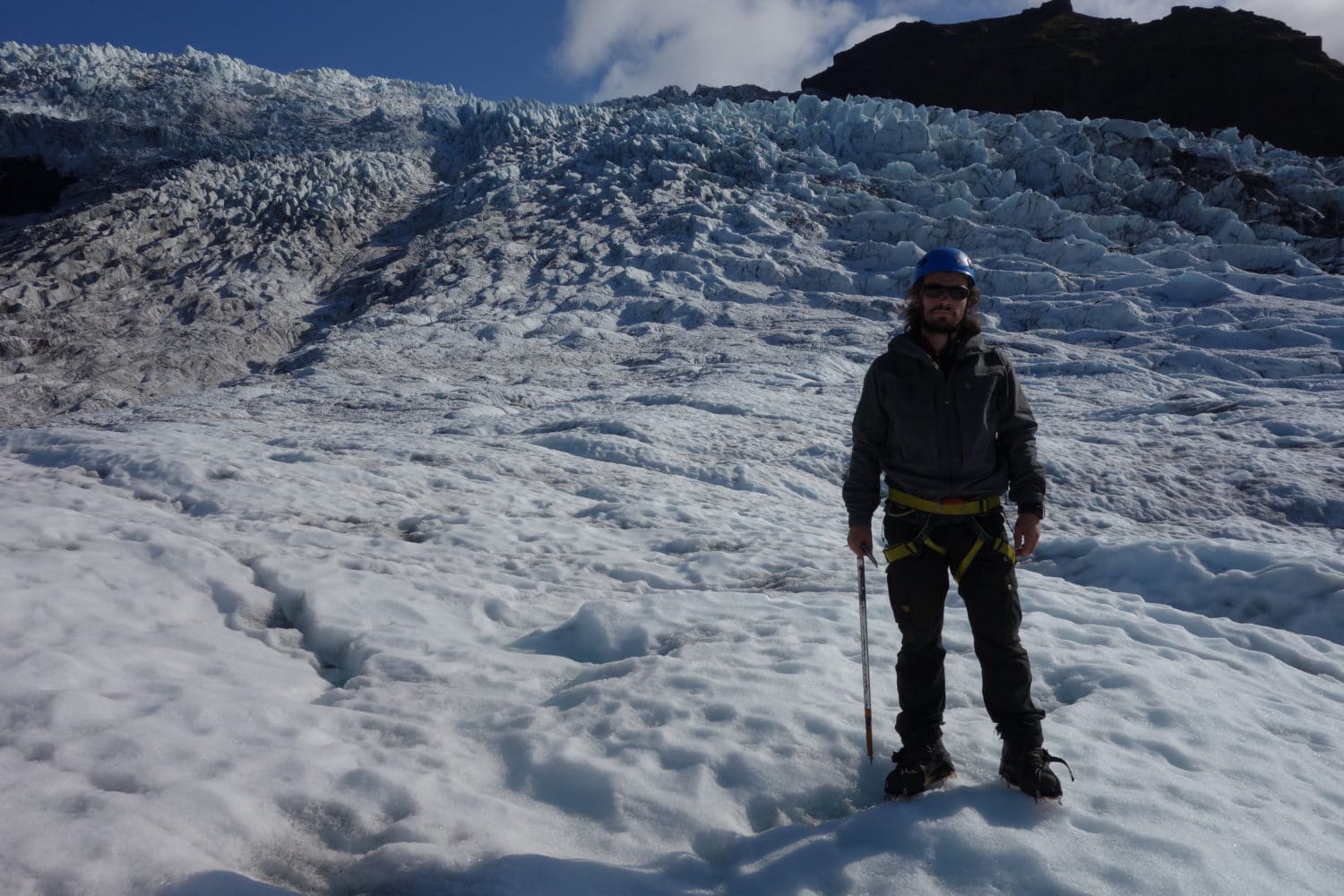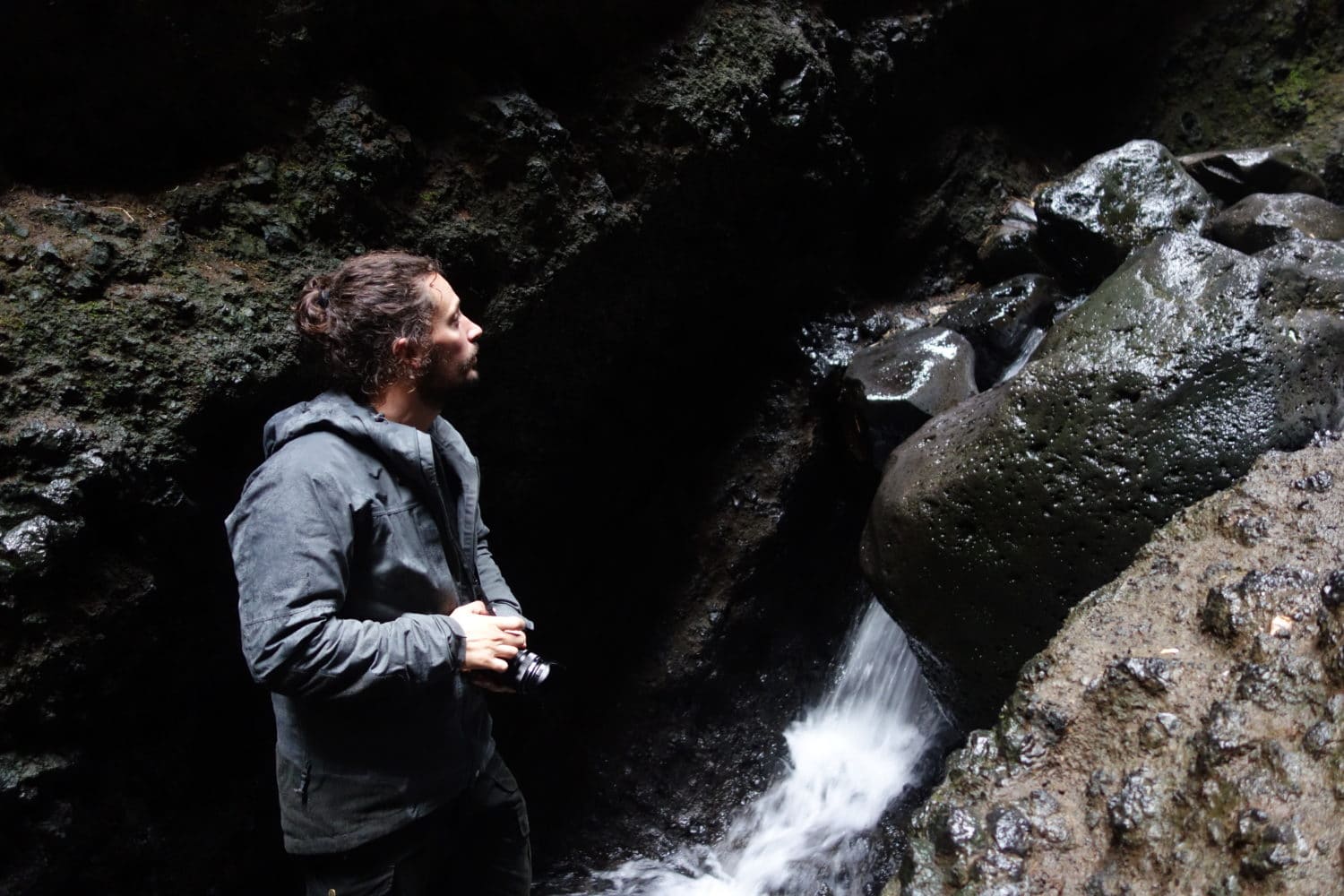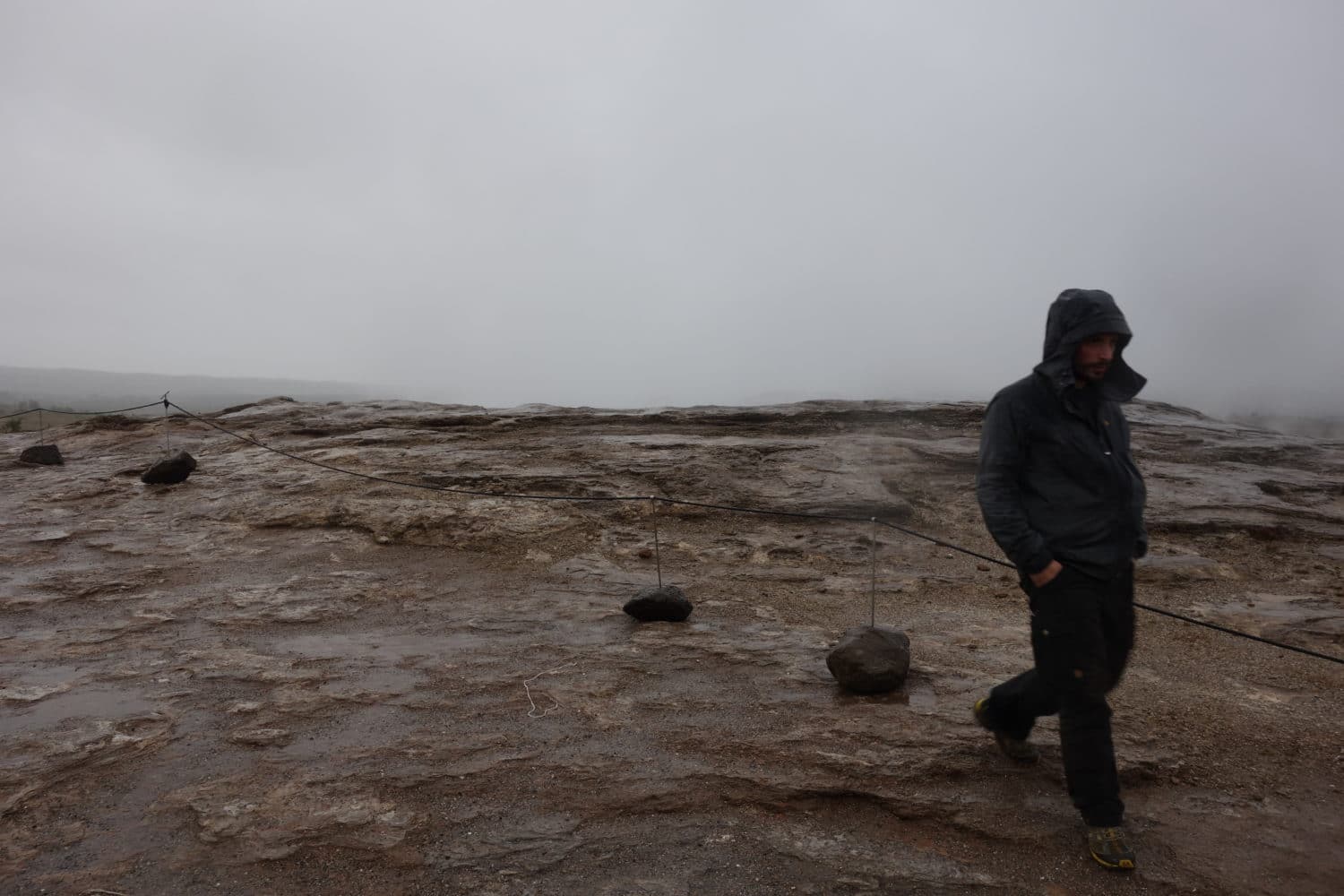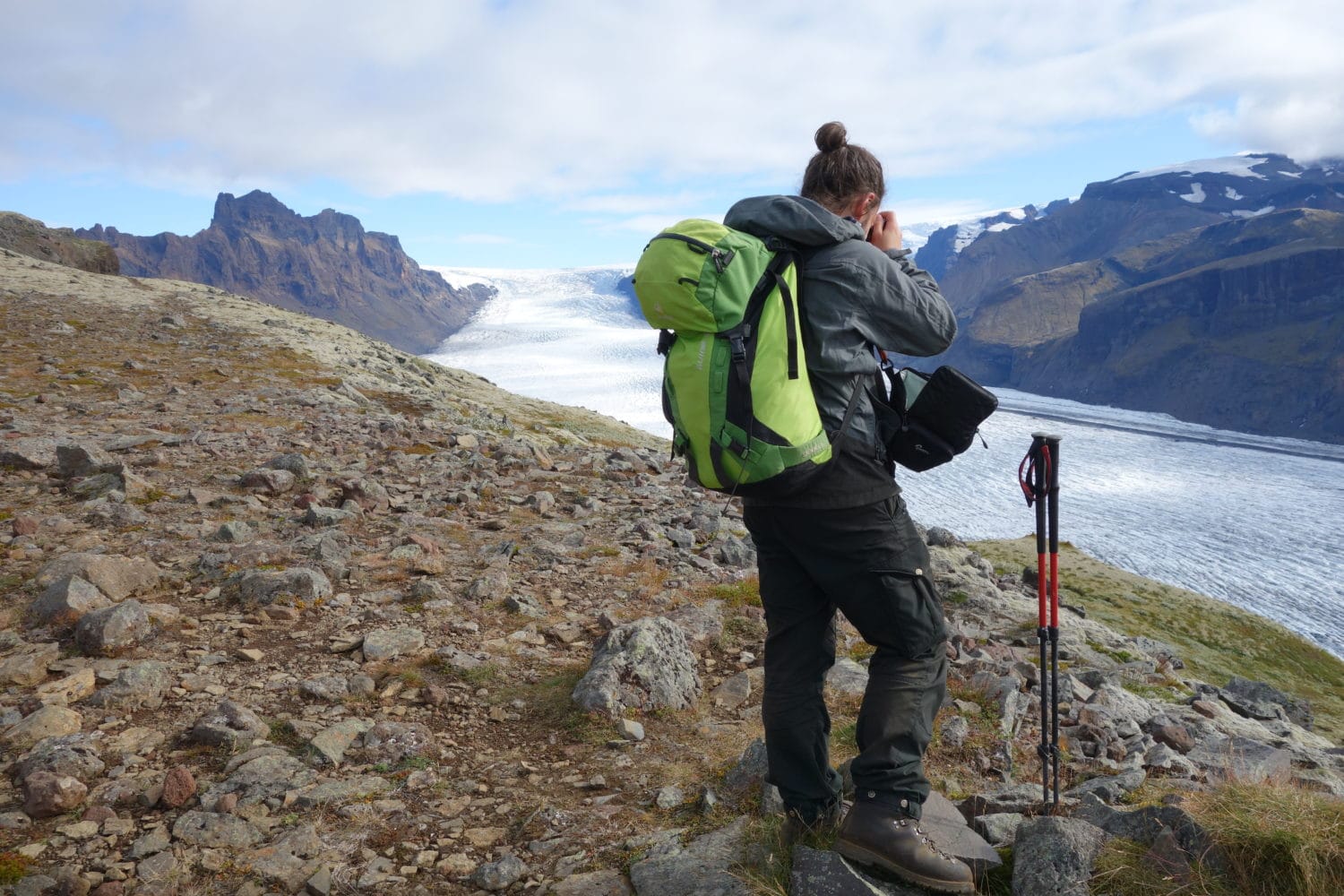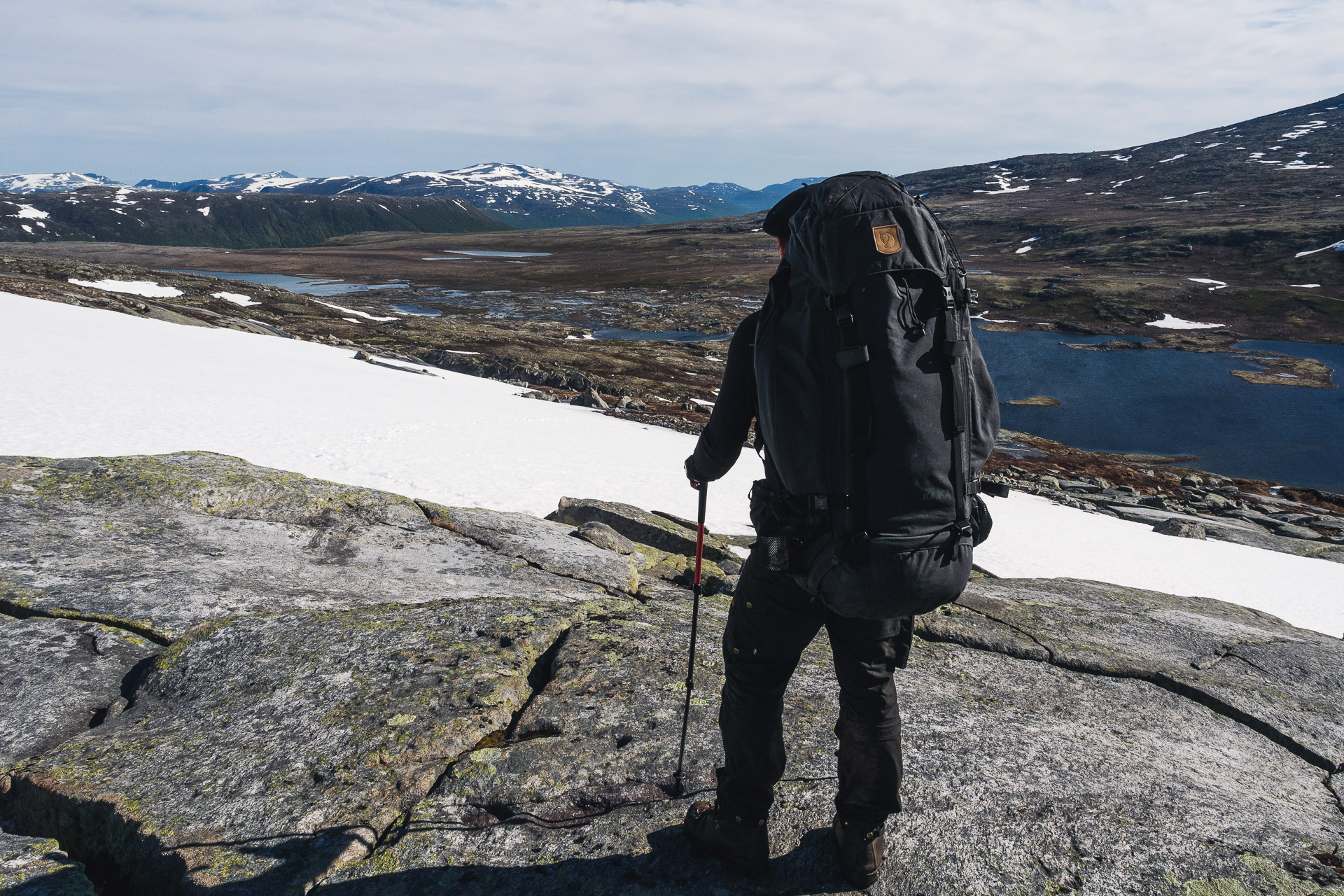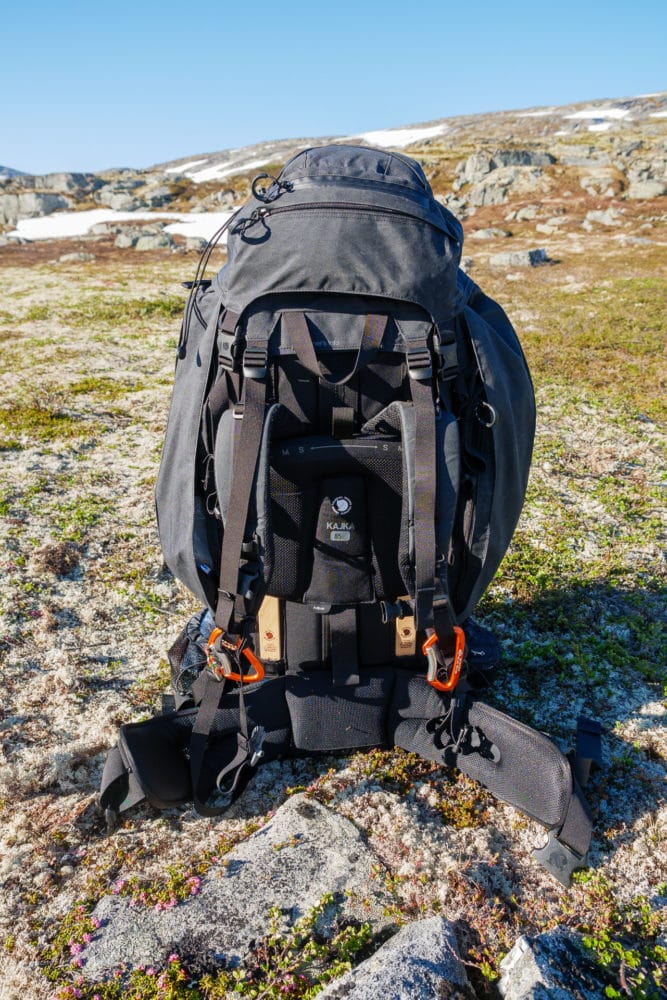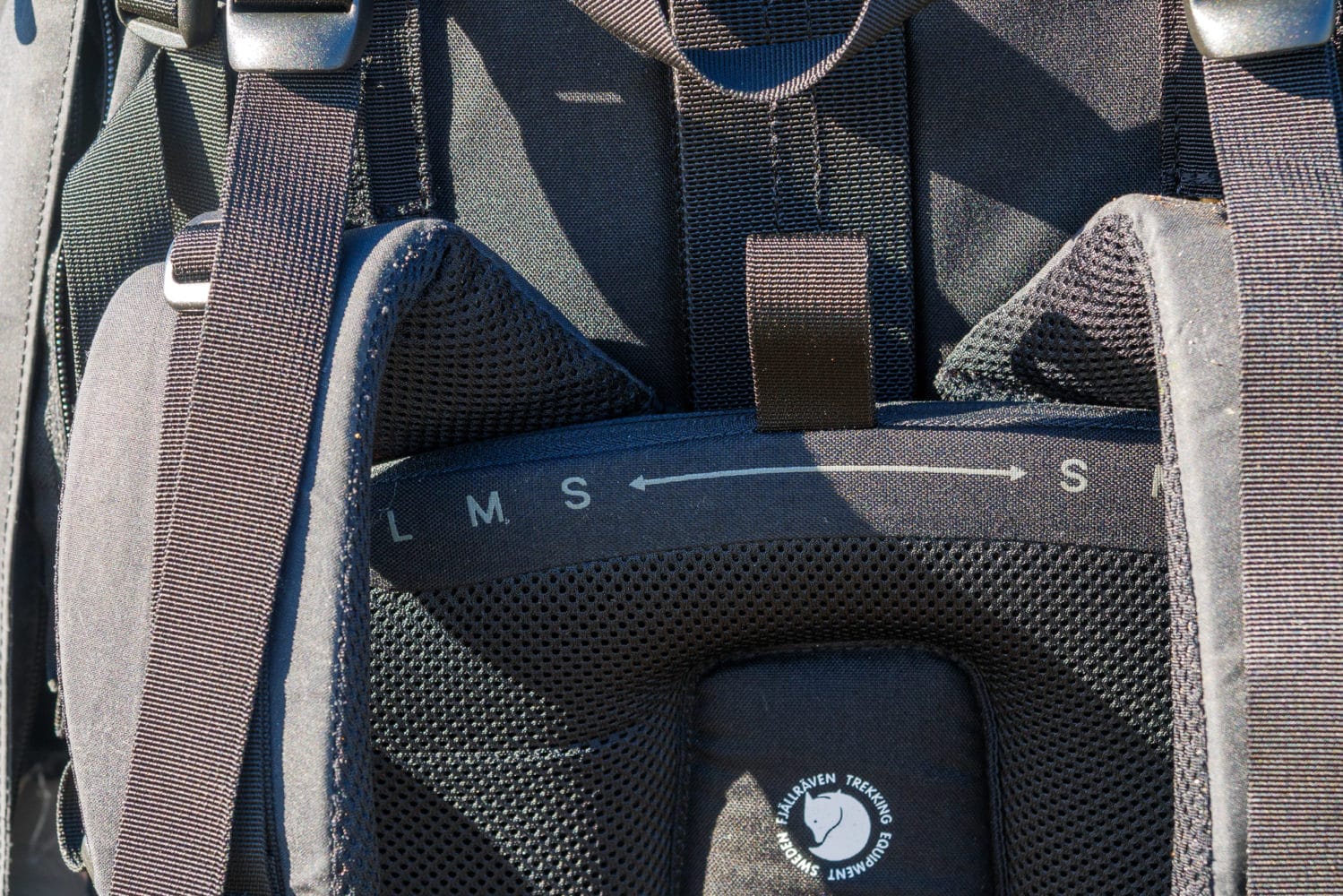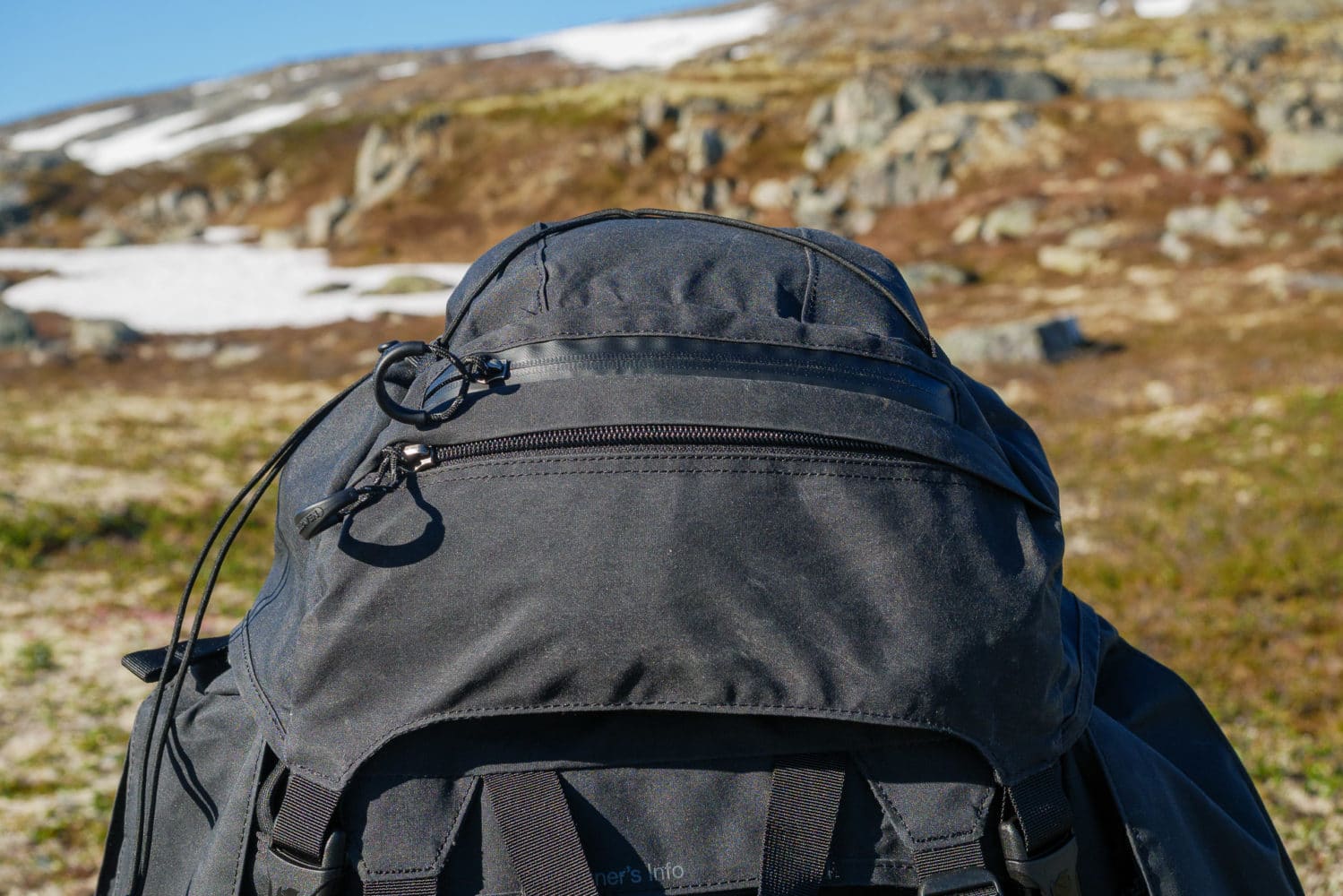Hillerberg ANJAN 2 Tent
Test & feedback of the HILLEBERG ANJAN 2 tent
The Anjan 2 tent from Hilleberg is a tunnel type tent intended for 3 season use. Hilleberg is renowned for the quality and solidity of its tents, which will be confirmed when using this model. But this comes at a price and not the least …
Test conditions
In total those are about 50 nights that we spent in the tent in the Scandinavian countries, in Iceland, in the mountains, … It will have seen all the weather: big sun, light rain, downpours, wind to decorate muskoxen …
List of main outings:
- Lofoten Islands
- Kungsleden
- Pyrenees
- Crossing the Vercors
- GR738 – Crossing of Belledonne
- Sarek
- Dovrefjell
- Iceland – Laugavegur
We were often two in the tent and with bags varying between 55 and 80L. We will come back to the habitability and comfort below.
General informations
- Nb of people: 2
- Seasonality: 3 seasons (but quality 4 seasons)
- Total length: 3.25m
- Interior length: 2.20m
- Apse length: 1.05m
- Total width (without shroud): ~ 1.40m
- Max living width: 1,30m
- Living width at feet: 1.10m
- Max living height: 1.00m
- Total floor area: 4m²
- Living area: 2.8m²
- Apse area: 1.2m²
- Weight: 1.80kg
- Tissue :
- Exterior: Kerlon 1000
- Interior: 10D ripstop nylon
- Floor mat: 50D ripstop nylon
- Impermeability:
- Roof: 5000mm
- Floor mat: 120000mm
- Fixing points: 12 (8 at the tent and 4 guy lines)
- Available colors: Green (tested model), red, sand
- Sale Price: € 825
(Manufacturer information)
Assembly and disassembly
Hilleberg tents are particularly well thought out at this level and it is a pleasure to put up and take down the tent.
For the assembly, it is enough to take out the tent, put two stakes at one end, thread the two poles and tension the whole before putting back two other stakes. In easy conditions, the operation will take 5 minutes, in difficult conditions, a little more time but this can be done quickly even on its own. Once these four stakes are installed the tent stands upright but we can add another 9 others, the tent is then completely concrete!
Big advantage of the Anjan 2: it mounts with the double canvas already in place. It is a big time saver and especially the inner canvas is protected from the rain.
Significant disadvantage but inherent in the “tunnel” type of the Anjan: it is not self-supporting. You will therefore need to be able to fix it to the ground.
For disassembly it is the exact reverse operation and it does not take more time. The bag provided to transport the Anjan has the good taste of being a size perfectly suited to easy storage, so there is no hassle in storing the tent.
The tent is also supplied with a repair pole section in the event of breakage, which can be very practical.
Once folded the tent occupies a cylinder of about 50cm in height for a (malleable) diameter of 20cm which allows it to fit in a backpack or store it outside of it that does not interfere .
- Take the tent out of its transport bag (in case of wind beware of the latter)
- Unroll the tent with the side opposite the door in the direction of the wind (if the latter is very strong and you are alone, do not hesitate to attach the tent to your bag for example)
- Plant the stakes in the two eyelets on the windward side.
- Insert the hoops: the large one is marked with a red mark on the hoop and the canvas
- Insert them into the provided eyelets
- Fix the stakes at the door by stretching the canvas in the axis of the first stakes attached (the front and rear stakes must be parallel).
- Stretch the canvas with the straps around the edge of the tent
- Fix the tensioners and stretch them: the longer they are "horizontal" the better it will hold in the wind. Do not tension them too much (they must not distort the tent)
- There you are!
DISASSEMBLY:
- For disassembly, simply repeat the same operations backwards.
- I advise you to "fold" the tensioners well so that they do not get tangled during storage / transport
- Relax the canvas too
- For the final folding:
- Fold the door towards the "center" to form a rectangle
- Fold the rectangle in 3 lengthwise, it should be wide like the folded arches
- Place the poles (in their bag with stakes) at the windward end and roll the canvas around.
- Put everything in the transport bag
NOTE: pitch the tent on a surface that is more rounded (convex) than hollow (concave). If only for the flow of rain but also to be able to stretch it well.
Installation option
The assembly presented is the basic one, but Anjan offers many alternatives!
- You can only mount the outer fabric using a cord to stretch the ends of the poles.
- You can mount the inner canvas alone if time permits (pass the hoops in the loops that normally connect the two fabrics.
- The rear side can be raised to improve ventilation
- The apse can be partially or fully folded to improve access and sight
These options are very practical in hot weather.
Weather resistance
Hilleberg is a Swedish brand, so they make tents that withstand the Swedish weather. Ie solid tents !!
Faced with the rain there is nothing to complain about. I never leaked water from the tent or the apse. The cut of the canvas protects well even if there is wind. You just have to make sure that you don’t touch the outside fabric (the bags in the entrance or at the feet for example). Rain level no worries even in heavy rain that lasts a long time. The ground carpet also does its job very well as long as you don’t pitch the tent in a swamp and avoid heavy pressure on the carpet. You will therefore be dry with this tent.
As for the wind, it’s solid too. There are 12 fixing points in all. Suffice to say that Eole will have to deploy a little energy to uproot the tent. Unlike other tents I have had in the past, it does not fold downwind. Indeed, the shrouds are placed so as to support the hoops well and the whole is very stable. So no worries about the wind resistance, which we could test several times … Only worries, the orientation of the tent in the wind. The latter is tunnel type, this means that it will not support the wind in the same way depending on its orientation: if the wind blows in the direction of the main axis of the tent then no worries, however if the wind breath through the canvas then has a tendency to snap which can be disturbing. The outside fabric will also tend to widen on one side and swell on the other which can be annoying in the interior space. It is therefore “enough” to set up the tent with the correct orientation, hoping that the wind will not turn! This inconvenience has never been a big concern but it must be kept in mind.
I did note, however, a slight tendency to condense in the outer fabric. To compensate for this, I open the top of the front door a little to make a little “draft”: the wind rushing between the fabrics thus ventilating a little better.
Resistance over time
The Hilleberg Anjan 2 is a solid tent. First of all thanks to the textiles chosen: kerlon 1000 is a very resistant material (abrasion, tearing) and which can be repaired quite easily. Similarly for the floor mat or the interior canvas, we can trust these fabrics.
The hoops are solid, no worries at this level. The tent is sold with a repair section in case (the critical moment to break the pole is during assembly / disassembly: we quickly walked on the pole). Likewise all accessories (zippers, rings, straps, …) are solid.
After 50 nights spent in it and as many erection / dismantling on all types of terrain, the tent today shows no clear sign of fatigue or wear. Not even a small hole in the floor mat.
This tent is solid. Just use it following the manufacturer’s recommendations and common sense and it will last over time.
Roominess and comfort
Important point: is it a comfortable tent? Well overall yes with some reservations …
As mentioned above, the tent is easy to pitch, with different configurations to adapt to the weather, so it’s a good point on this side.
From an interior space point of view it’s good for two without being very luxury either … In terms of length it’s good for my seventy meter but a friend who is in 1.85 had a tendency to touch the backdrop which can cause moisture on the sleeping bag by capillarity. In width, it is not bad, enough to put two classic mattresses and still have 10cm of margin … We will find two pockets at the entrance door quite practical and good size. A short cord at the level of the interior canvas ceiling, very practical for hanging up your socks in the evening or hanging a small lamp. In terms of height, it is limited. We sit quite comfortably towards the front of the tent but impossible at the back, and again we must not be too tall. We will therefore rather lie inside, especially for two.
In the apse, I can easily store an 80L bag as well as a 60L bag with the shoes next to it. By cons in this configuration there is more room. It can be annoying to cook under the apse (those which is not recommended, however).
The front door is well done although it can sometimes be uncomfortable to close it if you are in your down. On the other hand the fact that there is only one door makes that one inevitably hinders the other a little to enter / leave …
Very positive point: the color of the interior fabric. This one is yellow and thus allows to always have a bright interior. Even if it’s gray outside. I must admit that I was really surprised by this point. It is very effective and pleasant to use.
Conclusions
We are here in the presence of a very good tent but which pays … More than 800 € for a tent it is very expensive (I bought mine 630 € in 2017 but the prices increased then). But the idea with Anjan is to keep it for a long time. This can therefore be profitable in the long term … to be confirmed.
If not this point, the tent is of excellent quality and offers real comfort in the face of the elements. We feel safe which is essential in trekking when our only shelter is this little piece of canvas … I am not at all disappointed with this purchase and I always have the same pleasure in spending nights at the bottom of the pampas in my little anjan 2.
We like :
- Resistance to the elements
- Finishing
- Robustness over time
We dislike :
- Living length
- The price
- The interior height
Fjällräven VIDDA PRO jacket
Fjallraven VIDDA PRO outdoor jacket - Test
The Fjallraven Vidda pro jacket is a jacket tailored for all outdoor activities. Durable and practical, it will satisfy you in your outdoor activities in all weathers.
Conditions de test
The Vidda pro jacket has been mainly tested during forest outings. It was also worn in a more urban situation which made it possible to face all types of weather (good weather, wind, (heavy) rain) and to test it over long periods of time.
Regarding dimensions, the jacket tested is a size M, I am 1.70m for 77kg. She is very good at the shoulders and in length. We could find it a little wide at the bust but in my opinion it gives a certain comfort especially if you wear thick layers of clothing underneath like a big wool sweater for example.
Global informations
- Brand : Fjallraven
- Price : 284.00€
- Weight : 850g
- Material : G1000 ECO
- Colors : "Dark Olive", "Deep forest", "Dark grey/black", "Black" (tested color) et "Dark navy"
- Link
Feedback
Look
Very subjective point but which also has its importance. I find the jacket pretty. It is well cut and simple in the good sense of the word. There are many pockets present but they do not spoil the overall look. Note the well-worked details such as the leather tabs and the push buttons with the image of the brand logo.
Cut
The vidda pro is well cut. As I said before, the cut is a little wide at the bust but it does not interfere in any way and allows you to wear a second thick layer like a big wool sweater for example. The sleeves are long enough not to go up if the arms are extended. The jacket does not impose constraints on freedom of movement as long as these remain “normal” (it is not a mountaineering jacket for example).
The length is very good, the jacket descends on the buttocks thus protecting well from the wind and friction of the bag.
Materials and Robustness
Like most Fjallraven products, the jacket is made of G1000 Eco, a solid and durable material. I use the jacket almost every day and not a point of wear in sight. If I compare to other products of the brand, I do not have any worries when it comes to keeping time.
Most of the “structural” seams are lined, guaranteeing additional durability. The shoulders seem doubled for more resistance.
The jacket in detail
The Vidda pro is a well finished jacket that offers a multitude of practical details
- The sleeves are wide enough to be worn over a pair of gloves. They are closed by a press button with two positions.
The jacket is not ventilated on the sides but given the objective of its design this is not surprising. We will rather use it in the intermediate season. - The central zipper is two-way which is always practical, it is also “doubled” by a flap with press studs ensuring a good seal. All zippers are YKK brand and have a tab for easy handling.
- The jacket has 8 pockets: 4 in the low position (two with vertical zipper and two horizontal opening with a press button) and 4 in the chest position (idem: two pockets with horizontal opening with a press button and two with vertical opening with zip.). The pockets are all protected by a flap that protects well from the rain. They are large and can store a large amount of material, including “horizontal opening” pockets. There is largely an IGN card (in height) or gloves or a hat. They also offer a clever system of loops for attaching equipment such as gloves or a knife. The only flaw, the position of the bottom pockets makes them unusable or uncomfortable when using a waist belt bag. This jacket is not cut for long-distance hiking at this level. Note: there is no inside pocket.
- The hood is effective but I have noticed several times that it does not ideally cover the face. I wear a bun that shifts it may be a little behind but I think a small ledge projecting more forward would have been welcome.
- To protect yourself from the wind, a drawstring tightens the bottom of the jacket.
Waterproofness and breathability
The jacket offers a good seal. I took a few good showers and I didn’t have any worries about leaks. Just a little water that came in through the opening of the hood at one time but I put it wrong.
I did not have the “pleasure” to test the jacket under the long showers but I think that it will defend itself well even if it will always end up crossing.
The seal can still be improved thanks to the brand’s Greenland Wax wax, but I haven’t found it useful to use it yet.
Regarding the wind resistance, there is not much to complain about. We are well protected at the bust and buttocks. We could however appreciate a slightly higher collar to prevent air from entering the neck when it blows from the front.
Price
The jacket is available at € 284 on the Fjallraven site. Even if this is a substantial sum, I do not find it excessive if we take into account the durability of the jacket and its finish.
Conclusions
We like :
- The style
- The cut a little wide to wear a good lining
- Accessories: pockets, accessory holders
- Sealing
- All the little practical details brought to the jacket
We dislike :
- The hood (not very covering on the face)
- No inside pocket
If you are looking for a nice jacket to walk in the forest, do bushcraft or any other outdoor activity then the Vidda pro is for you. The jacket has no major faults and performs its functions brilliantly.
Fjällräven BERGTAGEN jacket
Fjallraven Bergtagen windproof jacket - Test
The Fjallraven Bergtagen jacket is advertised as an all-season windbreaker. You will find below my return after a few weeks of use in real conditions.
Testing conditions
The jacket has been tested on two trips:
- The first in the heart of the Dovrefjell National Park in Norway. A total of 100km of hikes covered in 10 days in June in a terrain alternating short tundra, snow and rockery. In terms of the weather we had great weather and heavy rain. The bag was initially loaded at 17-18kg
- Second trip: Iceland in two parts: Laugavegur, 4 days for 55km of trek on the Icelandic highlands. Lots of rain and wind! Bag initially loaded at around 16kg and then 2 weeks of “classic” travel with a few day hikes.
These two trips made it possible to test the jacket in all conditions and long enough to have a good feedback.
General information
- Brand : Fjallraven
- Advertised price : 459.00€
- Weight (measured) : 698g
- Material : G1000 ECO lite et G1000 ECO
- Available colors : Graphite grey, "hokkaido" orange et "UN" blue
- Manufacturer website
Field review
Look
Always difficult to judge this argument as it depend of each. However, we can be sure that the jacket is beautiful and fairly sober. There is no fuss and everything in it is useful. Personally, I find it aesthetically successful. The orange model throws in and you will not go unnoticed in the mountains!
Fit
The jacket offers a real mountain fit. That is to say that it descends low on the buttocks to protect the lower back and thus does not rise when walking with a bag. The sleeves are a little long which allows not to have the arm which is uncovered during movements of the arm in extension for example. In addition, the collar and the top of the jacket are well covering in order to protect the neck and the bottom of the face from bad weather.
The overall cut allows good freedom of movement and the jacket does not interfere. I have the model in M for a template of 1.70m and 75kg. It also leaves room for wearing a protective layer underneath.
Material and toughness
The jacket is mainly made of the flagship material from Fjallraven the G1000 which has the reputation of being resistant and durable.
We will mainly find G1000 Lite Eco as well as G1000 ECO, thicker, on areas with high friction such as the lower back and elbows. A pledge of additional durability.
The seams are not lined which could have been appreciable but they all have a sealing tape on the inner face.
The jacket looks solid and does not show any wear after 150km of walking and almost 1 month of non-stop use in bad conditions
The jacket in details
Fjallraven knows how to build jackets and we find all this know-how in the small details of the Bergtagen:
- The sleeves are wide enough to be worn over a pair of gloves. They can also be easily closed thanks to large scratch easy to use even with gloves.
- There are two ventilation zips on the blanks which have the function of circulating air. Their size and positioning are adapted and well thought out. They can be easily handled even when carrying a backpack.
- The sliders used on the zips and cords are particularly practical, especially if you wear gloves. We don’t look for them for 3 hours. The zippers are also of good quality and slide well without blocking (YKK brand).
- Note the presence of soft tissue at the areas that will rub on the skin, that is to say at the chin and nape of the neck. Significant detail!
- The jacket has two large front pockets in the high position. They do not interfere when carrying a bag and remain accessible and practical. The opening is done by a zip located towards sternum. They both offer a small net inside to store his laptop for example. From a volume point of view you can easily store a card and small equipment.
- The hood is a wonder! It covers the head perfectly and insulates you from wind and rain (even if the waterproofing is to be reviewed as we will describe later). It is easily adjustable by a system of cords that allow it to be securely attached to your head without disturbing you.
- The jacket is equipped with a RECCO reflector, a system that will facilitate your search by the emergency services if necessary.
- To protect yourself from the wind, a drawstring tightens the bottom of the jacket.
Waterproofness and breathability
We are dealing here with a windbreaker jacket. In other words, you shouldn’t count on it in the rain. I was able to experience it in Norway and Iceland and I confirm it. Even the addition of Fjallraven “greenland wax” does little to seal it, especially since the wax leaves relatively quickly. On the other hand, the jacket performs very well against the wind, in particular thanks to its well covering cut. It is therefore necessary to favor its use for mountain outings in good windy weather for example. A waterproof alternative from the same family exists at Fjallraven, the Bergtagen Eco Shell.
Price
The jacket is offered at € 459 on the Fjallraven site. It’s a huge amount for a jacket! The brand does, however, offer durable and repairable products, which aims to avoid buying clothing or equipment too often. We can therefore see Fjallraven products in the long term.
Conclusions
We like :
- Look
- Comfort and the well covering fit
- All the praticable details
We dislike :
- Price
- Waterproofness (even if it's a windbreaker we could have hoped for a little better)
The Bergtagen is a beautiful jacket, no doubt if you use it under the conditions for which it was made.
Backpack Fjällräven Kajka 85
Backpack Fjällräven KAJKA 85 - Test
Test conditions
The bag was tested during two treks:
- The first in the heart of the Dovrefjell National Park in Norway. In total 100km covered in 10 days in June in a terrain alternating tundra, snow and rocks. We had sunny weather and heavy rain. The bag was initially loaded with 17-18kg.
- Second trek: Laugavegur in Iceland. 4 days for 55km trek on the Icelandic highlands. Lots of rain and wind! Bag initially loaded around 16kg.
These two treks made it possible to test the bag in all conditions and long enough to have a good feedback. However, I did not use the entire volume of the bag because you have to plan a lot (too much) of material to fill the 85L.
General informations
- Brand : Fjallraven
- Price : 399.95€
- Volume : 85L
- Weight : 3.45kg
- Size : H84cm x L39cm x P29cm
- Material : Vinylon
- Available colors : Black, Deep Green, Graphite and "UN" blue
- Manufacturer link
Retour d'expérience
I have long had a 65L bag from Gregory but this volume although consequent was sometimes limited especially for long treks in total autonomy and even more since I started to bring a lot of photo equipment. So I wanted to switch to a larger volume which will allow me to take more food but also not to have to play tetris every time I want to prepare my bag ; if I take off my sweater, for example, I want to be able to slip it quickly into the bag.
My preference therefore fell on the Fjallraven Kajka 85.
Look
This argument is purely subjective but I think this bag is very beautiful. It has a slightly retro look with simplicity and no frills. The finished wooden structure give it that characteristic touch. As often with Fjallraven, we note the concern for details with the leather logo for example.
Volume and weight
As the name suggests, this bag is 85L and as much to say it right away it’s huge! I no longer have any space concerns when I prepare my treks. However this immense volume combined with a very good robustness (point on which I will come back below) make it a really heavy bag when empty which is its biggest defect. With 3.45kg, this will certainly be a brake for some. However the Kajka being comfortable we do not feel this weight too much but it still makes as many calories to burn more each day.
Confort
The Kajka is intended to be a heavy carrier. I have not found a recommended mass limit, but I think that we can easily go up to 25kg (is that reasonable …?). For my part, I use the bag in a 15-20kg range and comfort is there.
The belt and the back support foams fulfill their function wonderfully and even with a heavy load and elevation I have never had back pain. Ditto for the suspenders. In addition, the multiple possibilities of adjustments mean that you can really adapt the bag to your body type (in height and width).
However concerning the flexibility of the belt during certain movements it could be better. We might like to be more flexible in terms of pelvic rotation. However, this does not interfere with normal walking or on slopes.
Last important point, the external pockets all offer zips with a large buckle which is particularly practical if you wear gloves!
Toughness
You immediately have a feeling of robustness with this bag. The main canvas is thick and “rigid”. We feel that we will be able to rub trees or rocks without problem. After 15 days of use I did not notice any wear at this level, which is reassuring (the reverse would have really surprised me).
The zips present are well sized, especially those of the flap of the front face. We are not afraid to handle them even if they remain weak points (which is true for all zip). Likewise, the various quick-closing systems are robust and seem to want to last.
Obviously this robustness is paid for in terms of weight as we have been able to evoke but to choose I prefer with blind confidence in the resistance of my bag rather than fear the slightest branch. Obviously, this bag is not however a tank and will remain sensitive to piercing or cuts.
Details
We find, as on most backpacks, different possibilities to access the main pocket:
- The first is the top opening. It closes with a practical cord system which could be improved.
- The second is located at the first third of the height of the bag. It is a zipper that allows access to the bottom of the main volume.
- The third, finally, is a large flap on the front part of the bag which allows access to almost the entire volume. Very practical, the only downside is that you have to systematically undo the compression straps to open this flap, which can be painful if you want to quickly access the interior.
The main volume can be divided into two sections thanks to an internal zip. The lower section is intended for wet items and the classic closing flap can be replaced by an integrated net. I did not use this function yet but it’s clever. A compartment for a water pocket is located on the back of the bag. I think it is suitable for volumes of 1.5 / 2L.
The Kajka also offers two side pockets. For once these pockets are not only there to look pretty !! They offer a real volume of storage and its very practical to use. I would say that we can put two 1.5L bottles per pocket at first sight. This is a real plus because I had many bags whose pockets were almost useless.
The upper hood on the other hand is not very practical. Fjallraven has chosen to put two pockets on the external part but ultimately if one is filled the other is almost more usable … I would have preferred a large volume (why not with an internal net) rather than two. There is also an interior volume that can be used for small equipment but nothing more. Note that the hood can be easily removed (practical when preparing the bag) and used as an auxiliary bag thanks to an integrated strap. You can also choose to fix it like a belly bag with two clips provided for this purpose.
On the basis of the Kajka, you will find two very practical nets also. They can be used to store equipment or a gourd / bottle thanks to an access on the side. However, you have to be careful because the bottle may tend to slip if you lean forward.
Finally you will find two small pockets on the belt, one “waterproof” the other in mesh. Both are large enough to contain small items to have on hand like cereal bars, a lip stick, … I like the idea of differentiating them.
Aesthetically I like this bag because it is stripped on the front but there are however enough to fix sticks with Velcro. Likewise, the underside of the bag has loops for attaching a tent, for example using a strap. I would nevertheless appreciate a system to easily fix a tent on the front side for example or on the sides. I find that the systems in place its means for this purpose.
Finally to finish, the rain cover provided does its job very well and will ensure you keep your equipment dry inside. It is however a little big because I think it is the same for the 100L model. It is not bothersome in itself but we could gain in volume and weight.
Price
The Kajka 85 is advertised at € 399.95 on the Fjallraven website. We will not hide that it is a sum more than substantial for a backpack. However, I acquired this bag with the idea of keeping it as long as possible without ever having to ask myself the question of its solidity and its durability over time. So I see it as an investment, normally with this bag I don’t have to buy any more. Another point to highlight is the particular attention that Fjallraven pays to the environmental impact of its products which is very good and which should be encouraged but which is also felt on the note I think.
Conclusions
We like :
- Toughness
- Style
- Volume
- Accessories, especially side pockets
We dislike :
- Weight
- Price
- Upper part (zip pocket too small)
Fjallraven demonstrates its expertise with this Kajka 85L. If we omit the weight it is almost a faultless. I bought this bag for a simple need: take enough food to go long and far and it’s mission accomplished.

